Why choose mixed media? Maybe you’re driven by a desire to use particular materials. Do you love the tactile details of stitched work and the broad brush strokes of painting, and want to combine both approaches in your work?
Or are you looking for a more powerful way to communicate your message? Could selecting media closely associated with your subject help to get your ideas across more clearly?
Our featured artists, Siân Martin, Joanna Barakat, Nerissa Cargill Thompson, Sumi Perera and June Lee, all take different approaches and use a variety of media. Their choice of medium helps them express their stories about personal connections, environmental awareness, social responsibility or issues of discrimination.
They explain how combining textiles and thread with other media can lead to a multitude of fresh possibilities. Some even discovered that working with mixed media has helped them reach a wider audience.
Presenting some of the artworks made by these artists, using paint, print, stitch, thread, casting, sculpture and model-making, we’ll show how their choice of media and materials supports the concepts behind their work.
Joanna Barakat
Artist Joanna Barakat, born in Jerusalem and based in Abu Dhabi, explores her experiences as an ‘outsider’. Palestinian embroidery motifs and symbolism play an important part in her mixed media work.
In Heart Strings, Joanna introduces Palestian stitch patterns into a painted acrylic self portrait showing her stitching her own skin. She stitches with black pearl (perlé) cotton, a thread traditionally used in Palestinian cross stitch, using waste canvas as a guide.
The eye is drawn to this quiet moment of stitching, with the dark paint tones in the background lending a melancholy but peaceful tone.
‘My first embroidered painting, Heart Strings, responds to a longing for connection. Through my research and the act of practising Palestinian embroidery, I feel more connected to being Palestinian than ever before.’
Joanna discovered that for centuries Palestinian women have used their embroidery skills to transmit ancestral knowledge and share stories, including their personal identity, beliefs, backgrounds, status and heritage. More recently, these stitches have been used to represent the dispersed Palestinian collective worldwide.
‘I became fascinated with the potential of using Palestinian cross-stitch embroidery motifs to communicate and express concepts.’
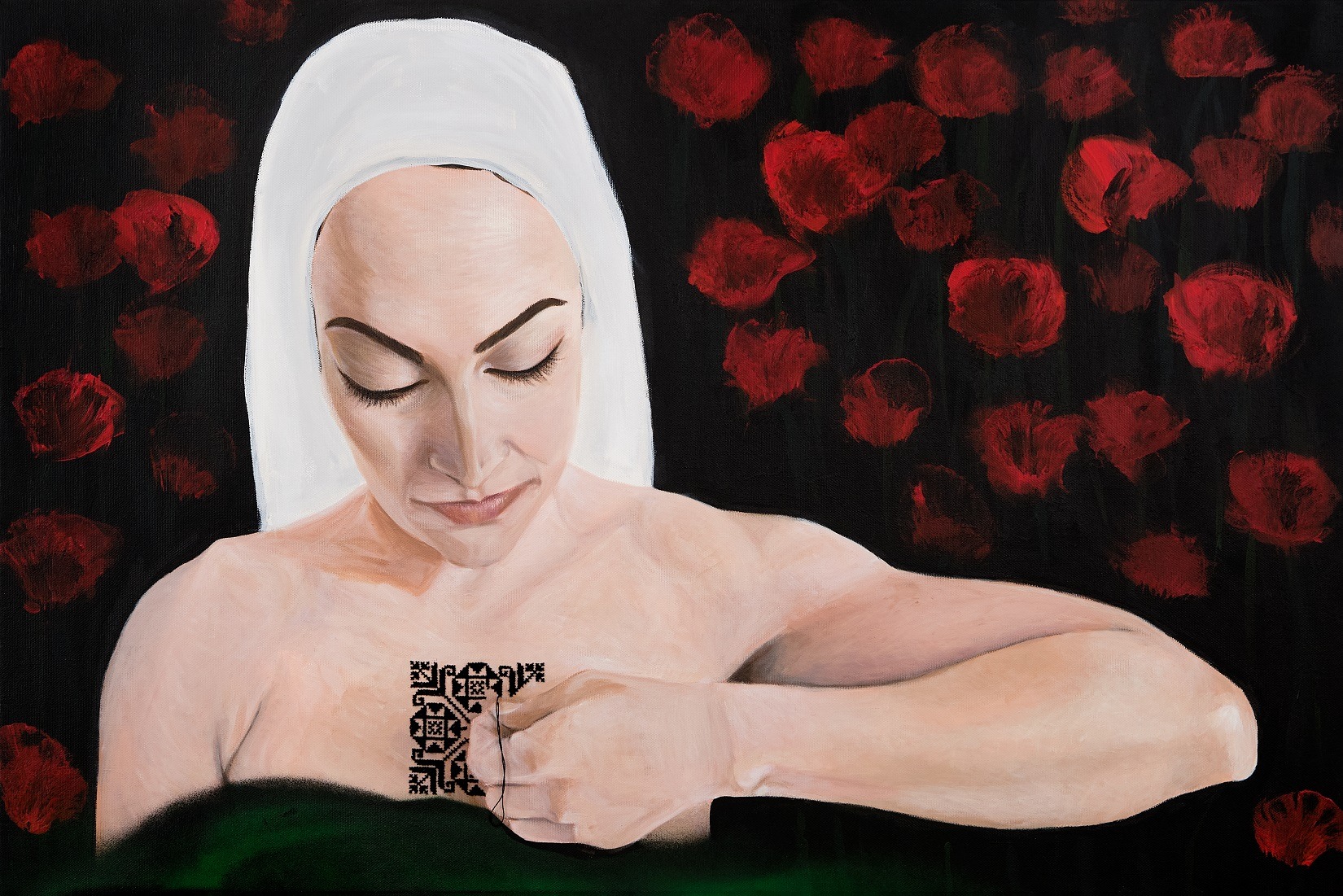
A feeling of separation
The stitched area provides the focus in Heart Strings, transmitting Joanna’s sense of separation from her ancestral homeland and addressing her desire to belong. In this portrait, she captures a moment where she is mid-stitch.
‘The act of stitching the motif on my skin is an act of remembrance. The traditional white headscarf, juxtaposed with the exposed skin, represents what we might wish to veil or reveal about our identities.’
This work became a key moment in Joanna’s journey. Palestinian embroidery and symbolism have both become an essential part of her work.
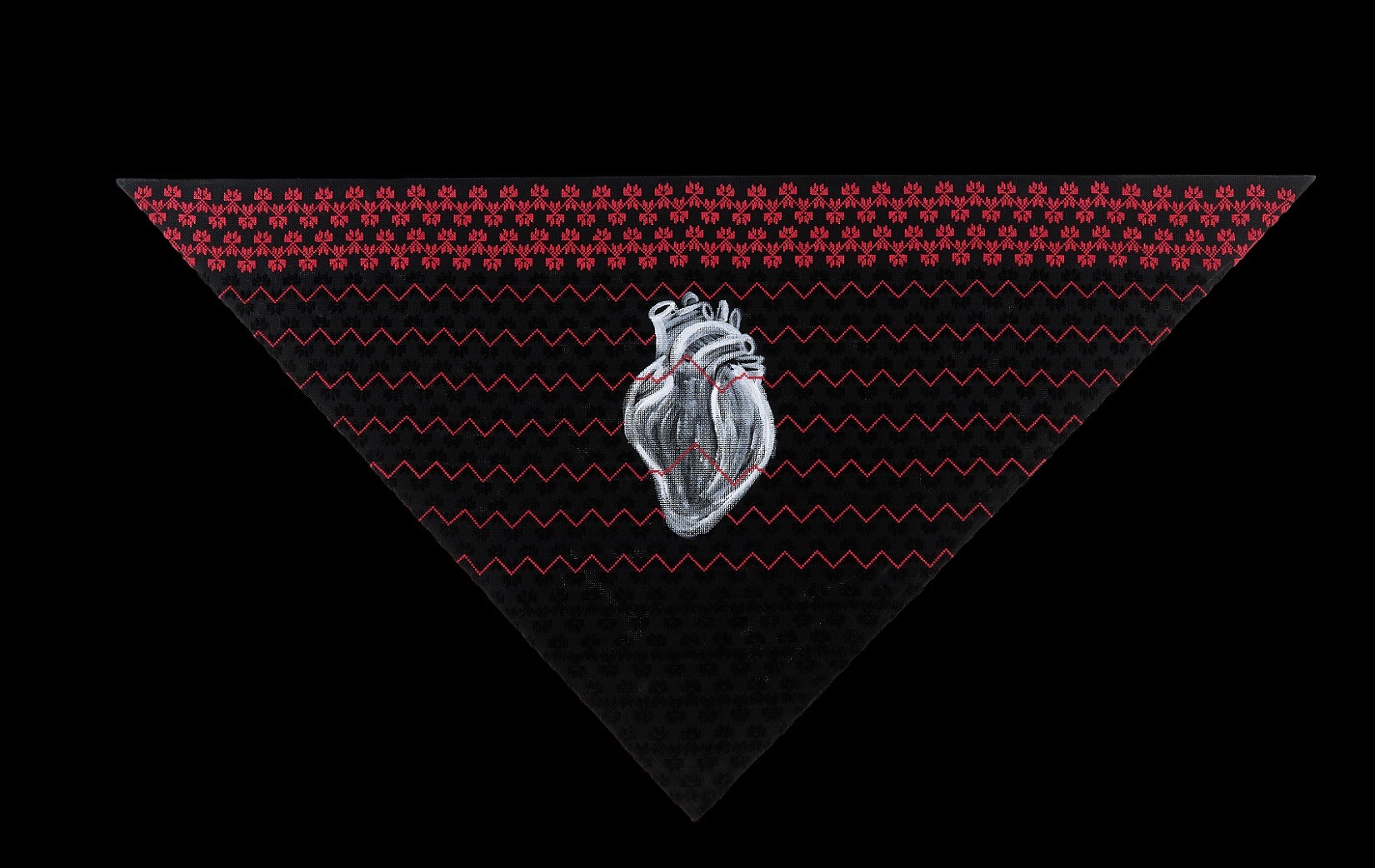
Joanna’s work Frequency of God (2019) shows a painted human heart, an expression of love and life on black aida fabric. Cross-stitched rows of a Palestinian carnation motif, another symbol of love, are placed above. Triangular waves of contrasting red stitches move across the heart. Joanna explains this work: ‘When we understand our existence as expressions of love, flowing in waves together, the answer becomes clear: God’s frequency is love.’
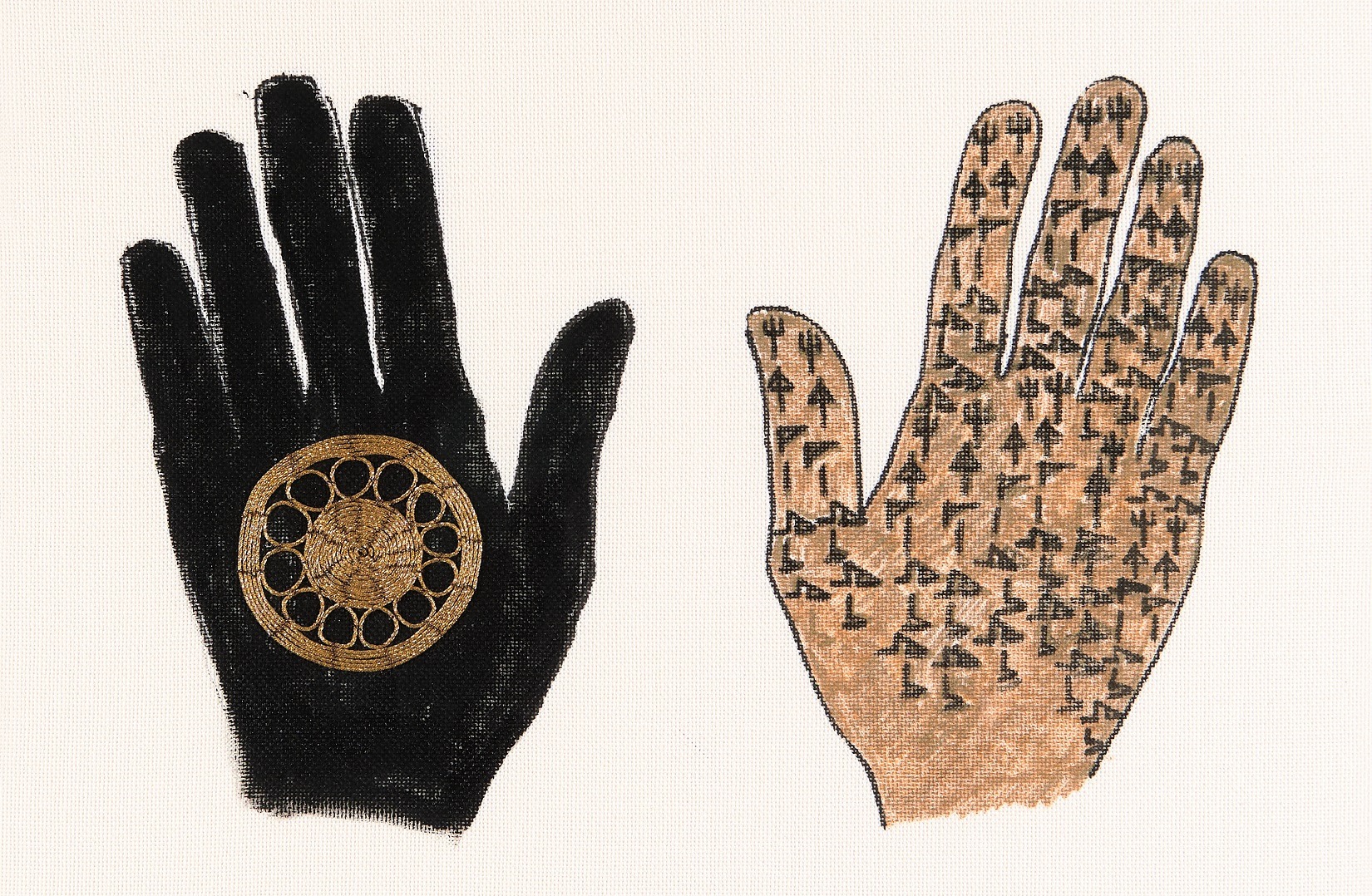
The power of a talisman
The hand of Fatima (khamsa or hamsa, meaning five) is a well-known talisman. And Joanna places a pair of hands centre stage in Amulet (2021).
Stitched areas unite with painted symbols to examine the flow of energy through the body.
Islamic prayer postures are painted onto a gold hand. Palestinian tahriri stitch, a couching stitch from Bethlehem, creates a circular protective eye on a black painted hand. Metallic threads forming 12 rings of a spiral are encircled by 12 smaller circles; 12 being a significant number in many sacred, spiritual and cosmological practices.
The versatile tahriri stitch allows Joanna to be fluid and spontaneous.
‘When stitching, there is an intention and a transfer of energy between the creator and the object created. Like an amulet, this intention gives the stitch its power.’
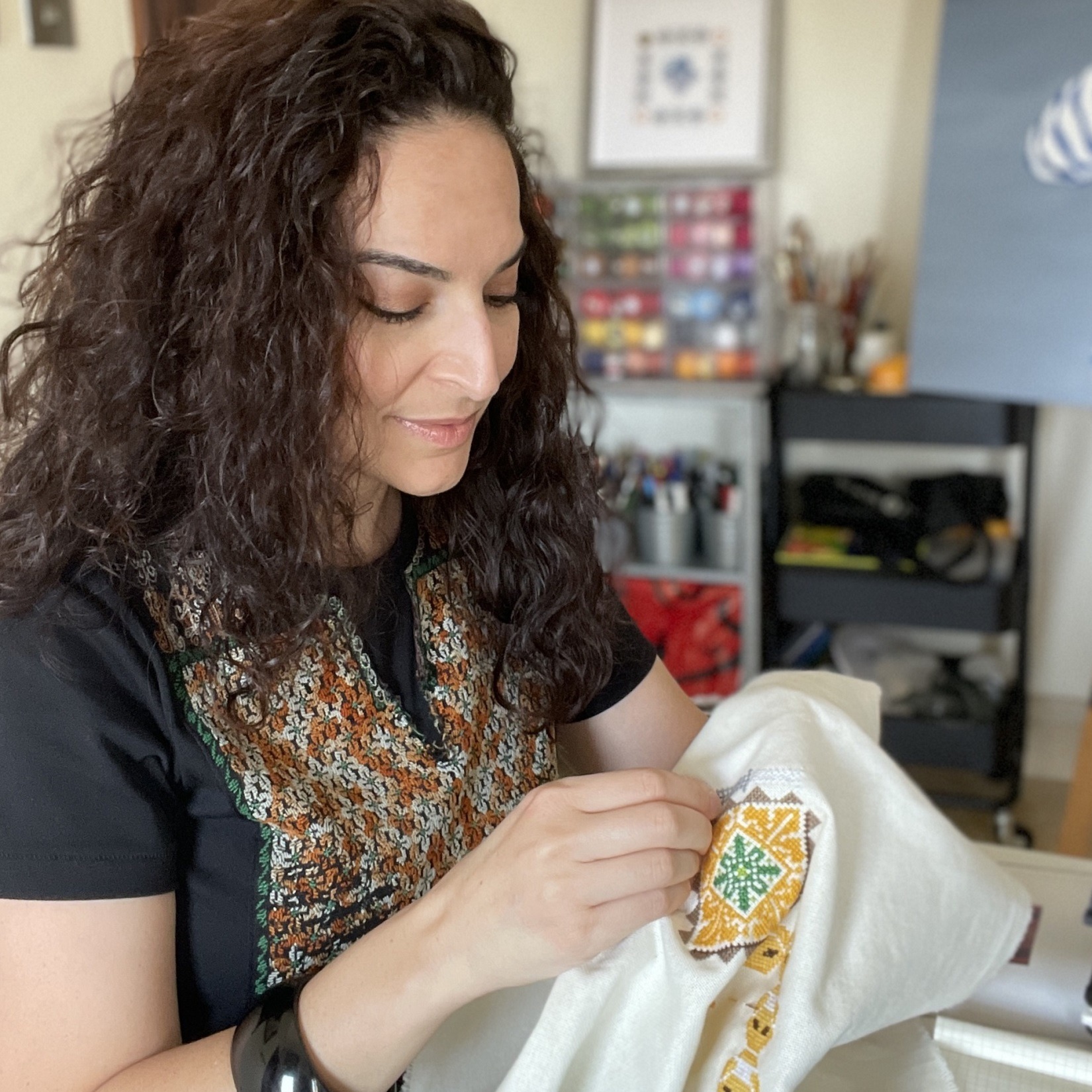
Joanna Barakat was born in Jerusalem. She was raised in Los Angeles, studied in London and is now based in Abu Dhabi. She holds a BA in Art and Design, University of the Arts London, and a MA in Global Media and Postnational Communication, University of London. Her degree project, a film about the physical and psychological borders imposed on Palestinians in the West Bank, was shown at the Institute of Contemporary Arts in London. Alongside her art practice, Joanna teaches Palestinian embroidery workshops and curates @thetatreezcircle.
Website: www.joannabarakatart.com
Facebook: facebook.com/joanna.barakat.art
Instagram: @joannabarakatart and @thetatreezcircle
Sumi Perera
Sumi Perera is strongly influenced by her dual nationality and hybrid identity. And mixed media layers play an important role in her work. She uses her art to explore issues of discrimination and the post-colonial European influences exerted by the Portuguese, Dutch and British colonists for 500 years on the native identity of her birth country, Sri Lanka.
Her work 35 Steps of Unconscious Bias grew from a self portrait, Roots (50 Shades of Grey), made during lockdown. Using her hair as thread and soft black hair dye as paint, her portrait covers up layers of text about colonialism and imperialism.
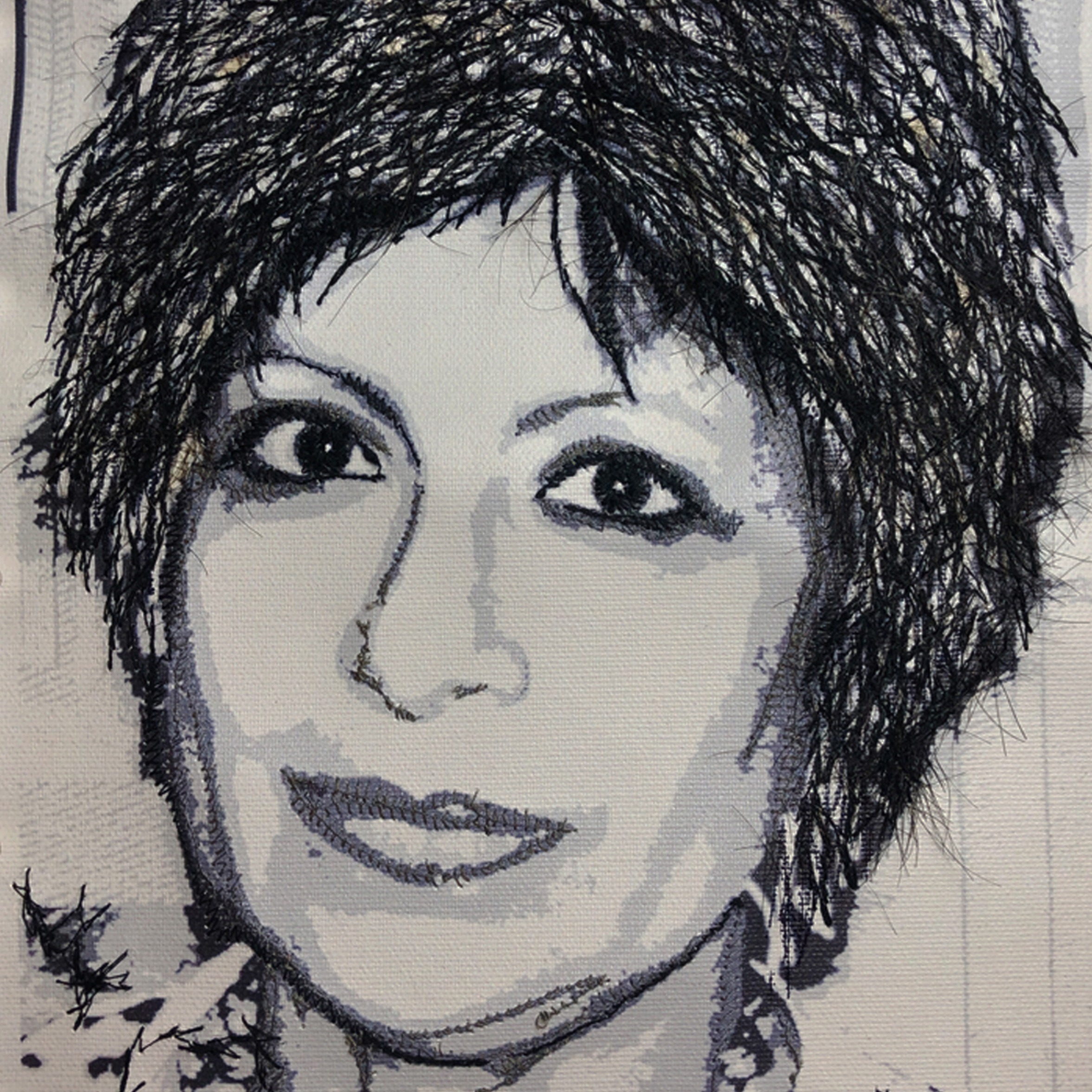
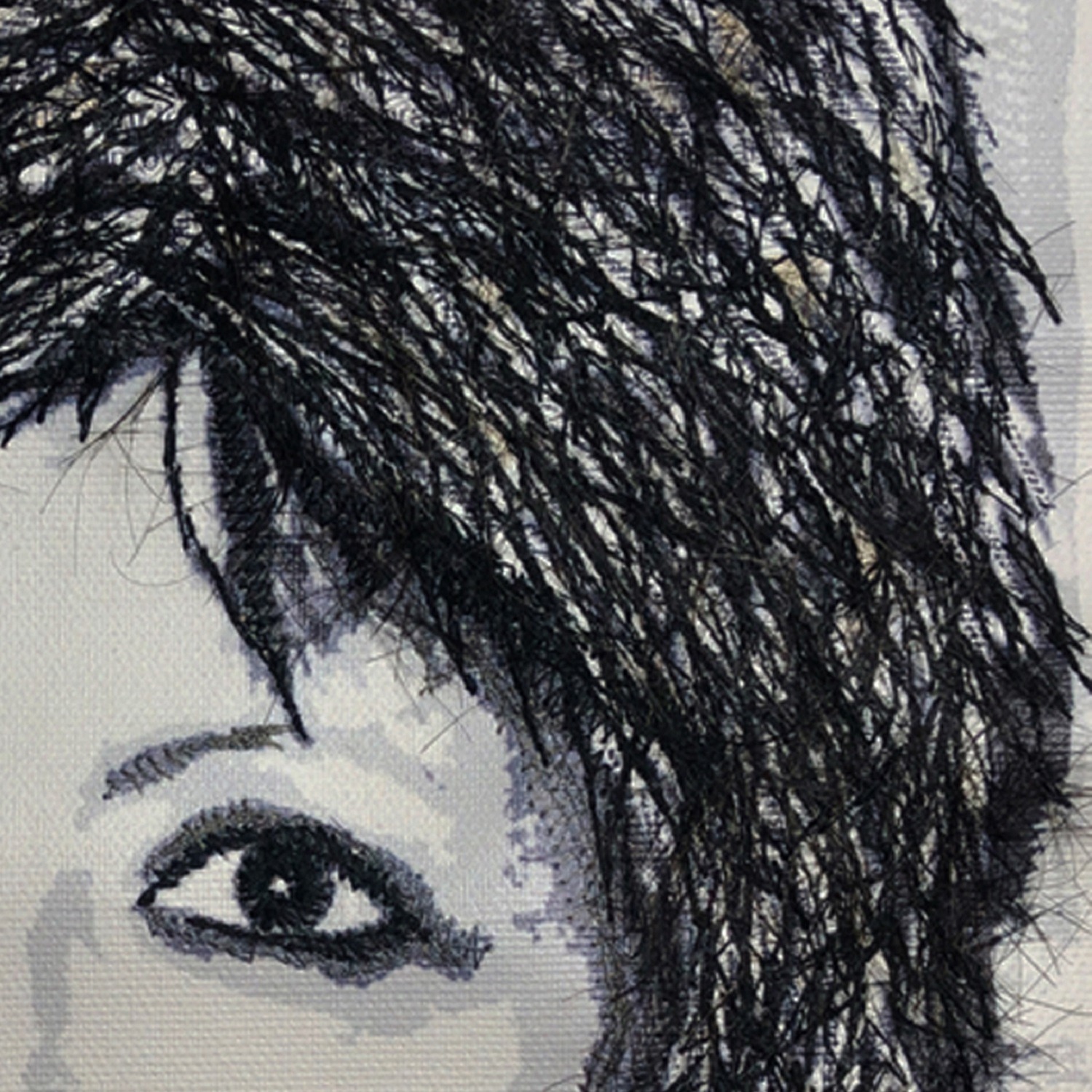
Her self portrait led to Roots – Not Black or White, But 50 Shades of Grey and Brown, where Sumi considers the prejudices inflicted not only upon people of colour, but also those dealing with socio-economic and other disadvantages.
‘I decided to incorporate stitched portraits of both my daughters and their bi-racial children. My granddaughter is half South African and my grandson is half Scottish.’
For this work, Sumi used her own hair along with fabrics collected since childhood. She ran the portraits through an etching press, using open-bite, acid-etched plates (where areas of the plate are exposed to acid without a resist). This meant that visually-impaired readers could feel the heavily embossed detail of the surface texture. She deconstructed these five portraits, mixed them up and over-printed them with text about colonialism.
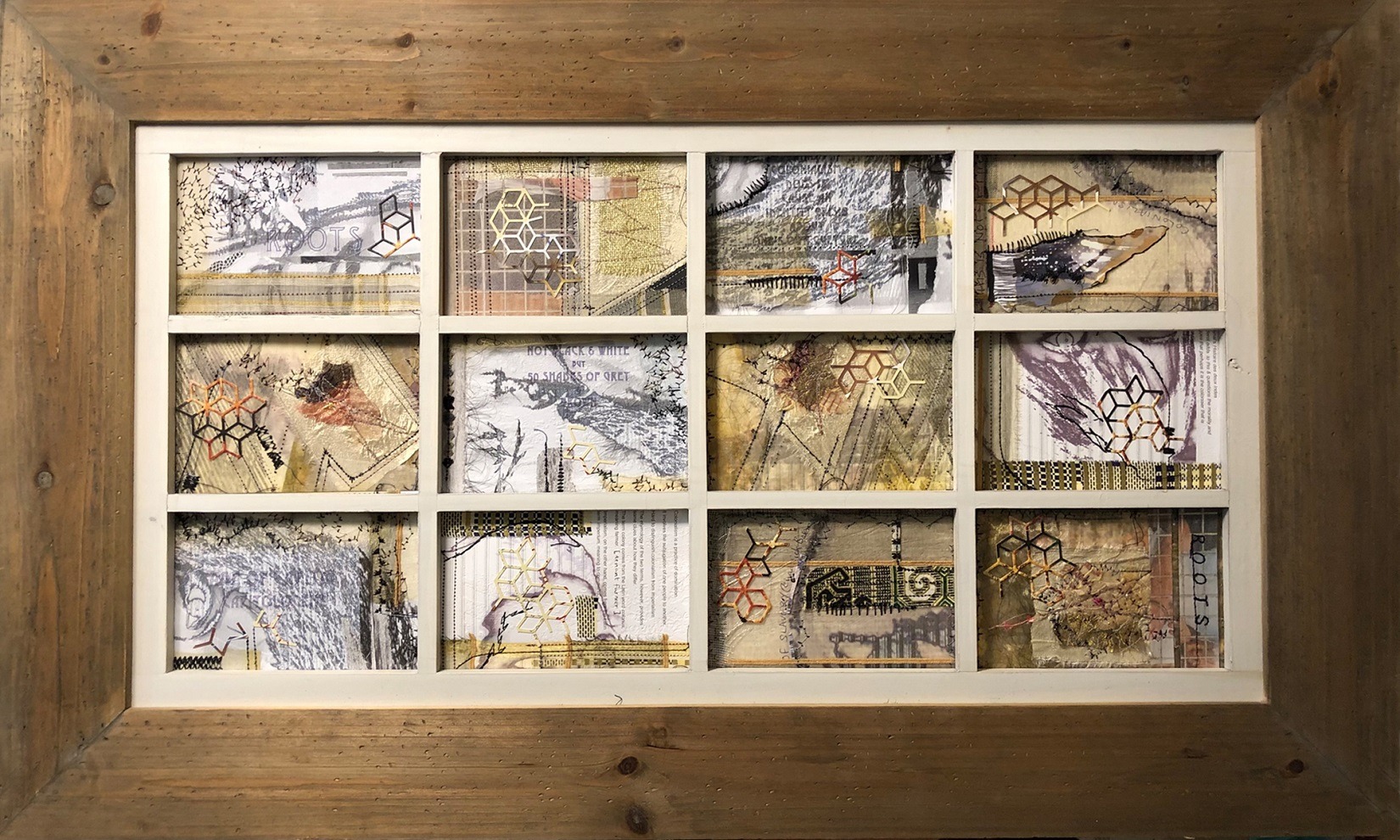
Unconscious bias
‘Bias or prejudice may be conscious or unconscious (implicit). Importantly, there should be no shame in implicit bias, as it does not stem from any fault in the individual, merely that the person is not aware the bias exists,’ says Sumi. She suggests that this ‘no-shame approach’ can help to reduce defensive responses, enabling acceptance, understanding, discussion and potentially lead to the resolution of discriminatory practices.
Building on her previous work, in 35 Steps of Unconscious Bias, Sumi represents a well-known exercise designed to enable reflection on privilege. A group of diverse individuals start off on an equal footing, but move a step forwards or backwards depending on 35 statements related to elements of their background, education and experiences.
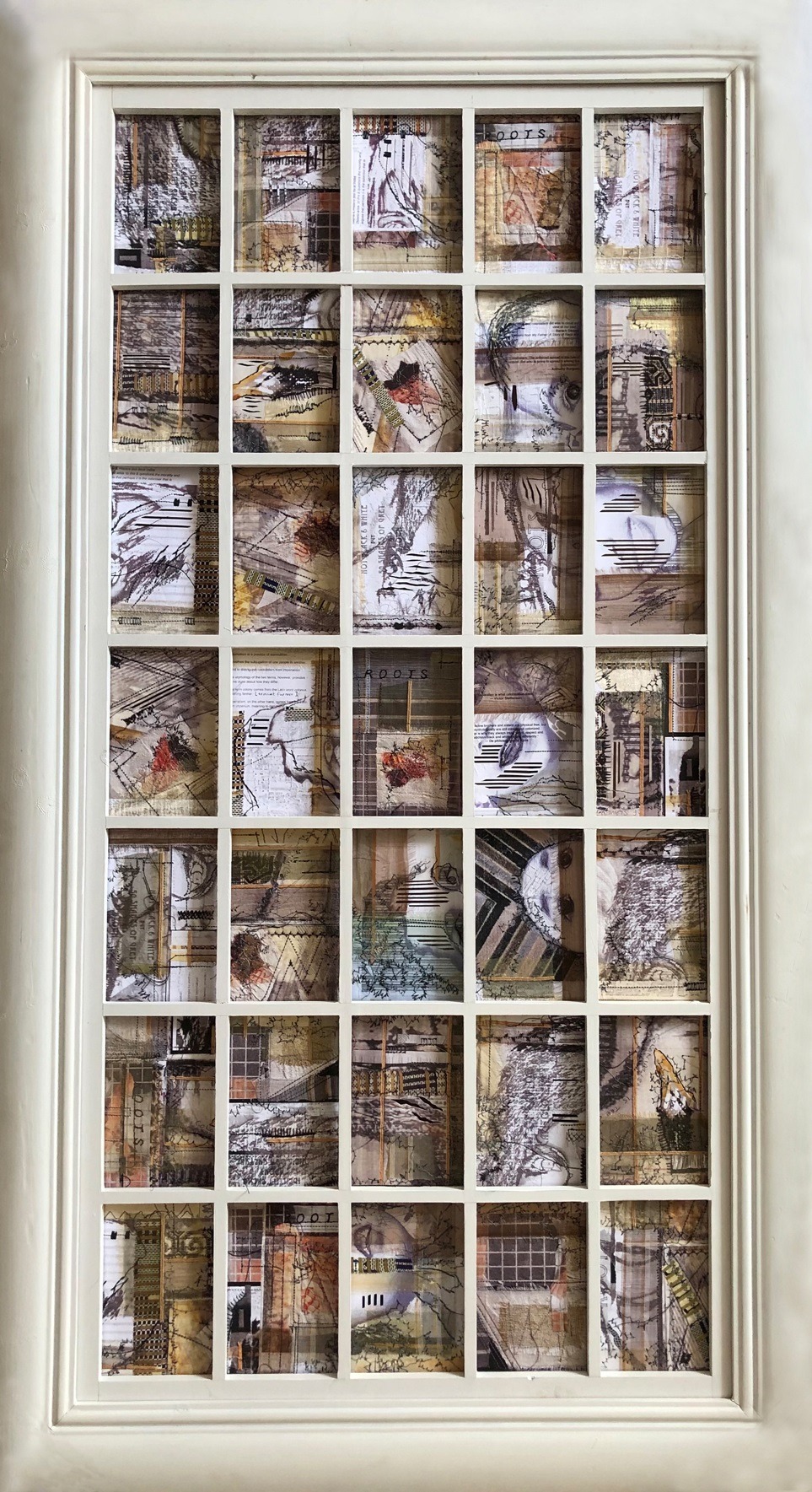
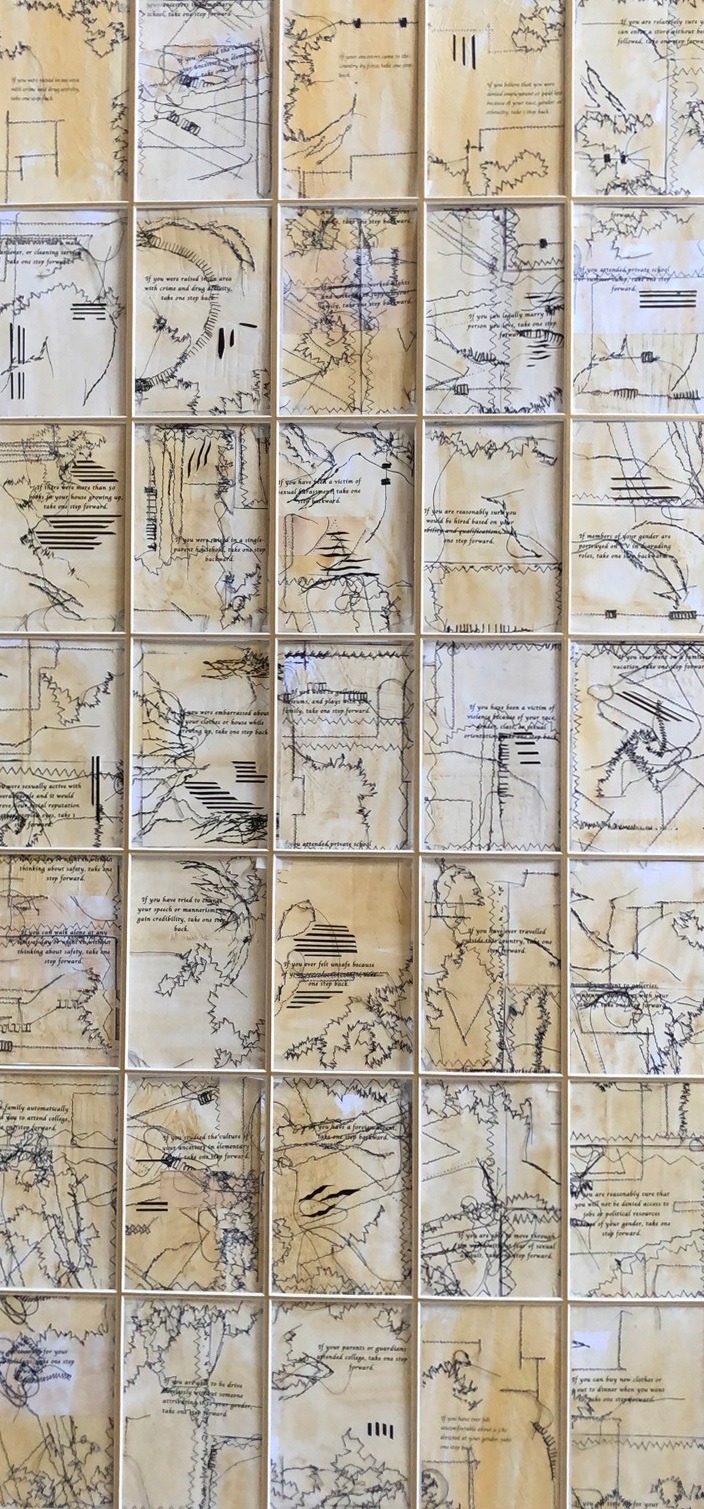
A double-sided viewpoint
Stitching 35 ‘pages’ of fabric and paper, and printing the 35 steps of unconscious bias on the reverse, Sumi created 70 images in total.
‘Intentionally, the front presentation was well-designed and neatly stitched, whereas the reverse sides of the pages were kept raw, with gaps, slippages and repair blatantly visible.’
Framing and presentation is an important part of Sumi’s art. This work is presented with the 35-aperture, double-sided frame hung perpendicular to the wall so that viewers can see both sides.
Sumi finds that combining different techniques appeals to a wider spectrum of textile artists, printmakers, and conceptual artists, and produces work that is easily read and understood by anyone. And by reaching a wider and more varied audience, the message behind her artwork can spread further.
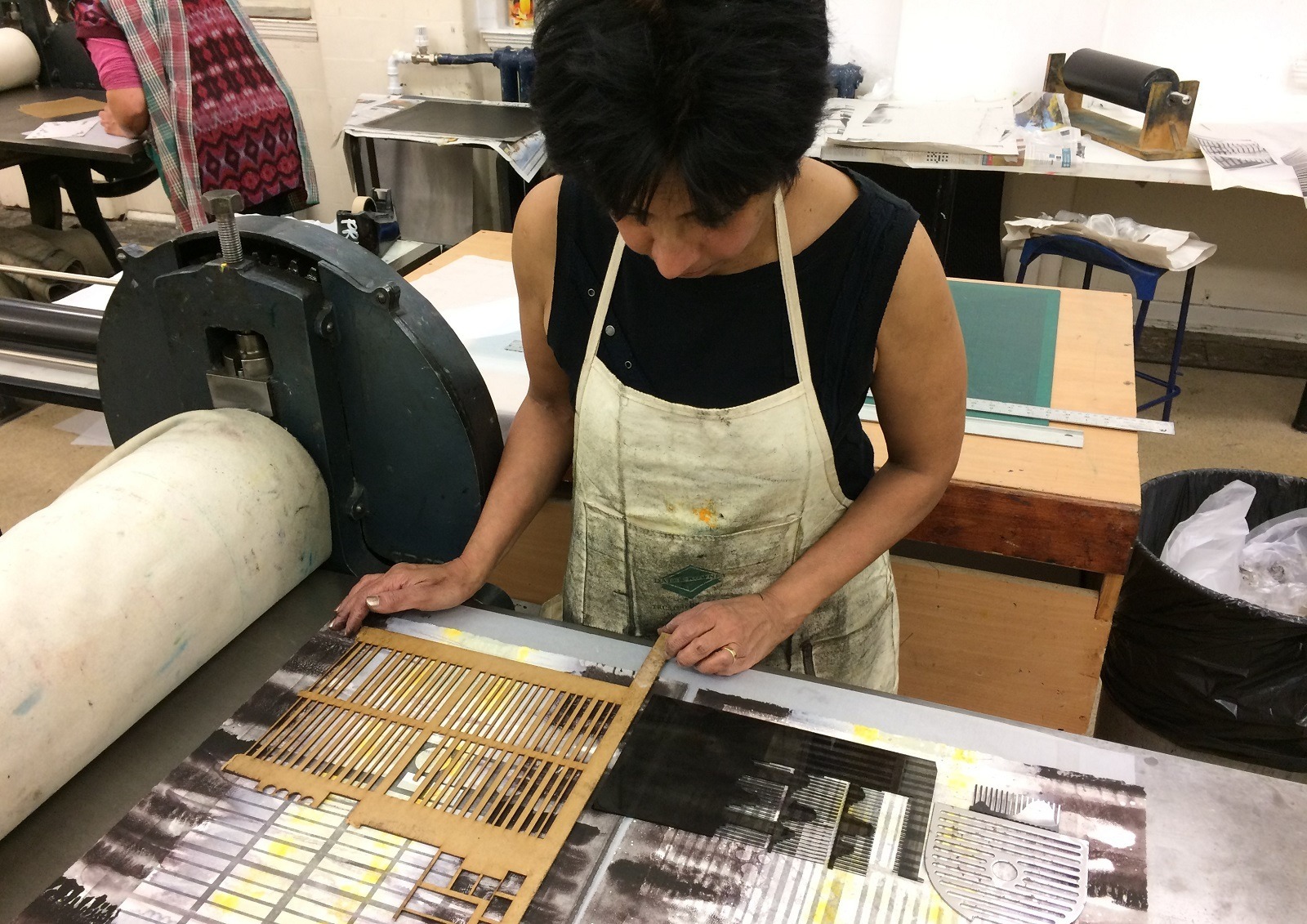
Sumi Perera uses traditional printmaking methods with contemporary techniques, such as laser-cutting and sandblasting, combined with traditional and contemporary methods of stitching. She was born in Sri Lanka, and lives in Surrey, UK. Sumi is a member of The London Group, the oldest artist collective in the UK, and the 62 Group of Textile Artists.
Website: www.saatchiart.com/sumiperera
Facebook: facebook.com/sumi.perera.71
Instagram: @sumi_perera
Siân Martin
Siân Martin describes her work in four ideas: linear rhythm; movement; environment; translucency.
Inspired by the natural beauty of the seashore, moors and wetlands of Somerset in the UK, Siân uses cloth, paper and stitch to convey the movement and layers of her local landscapes.
Her artwork Whispering expresses the rhythm and movement of reeds as the wind passes over the landscape in the marshy Somerset Levels.
‘Listening to whispered messages as the wind swirls around the marshes,
Whispering messages in the reedbeds,
And spreading secrets as the reeds and grasses dip their heads to hear,
The wind repeats the whispered secrets of the marshes,
Moving from one reedbed to another as if each in conversation.’
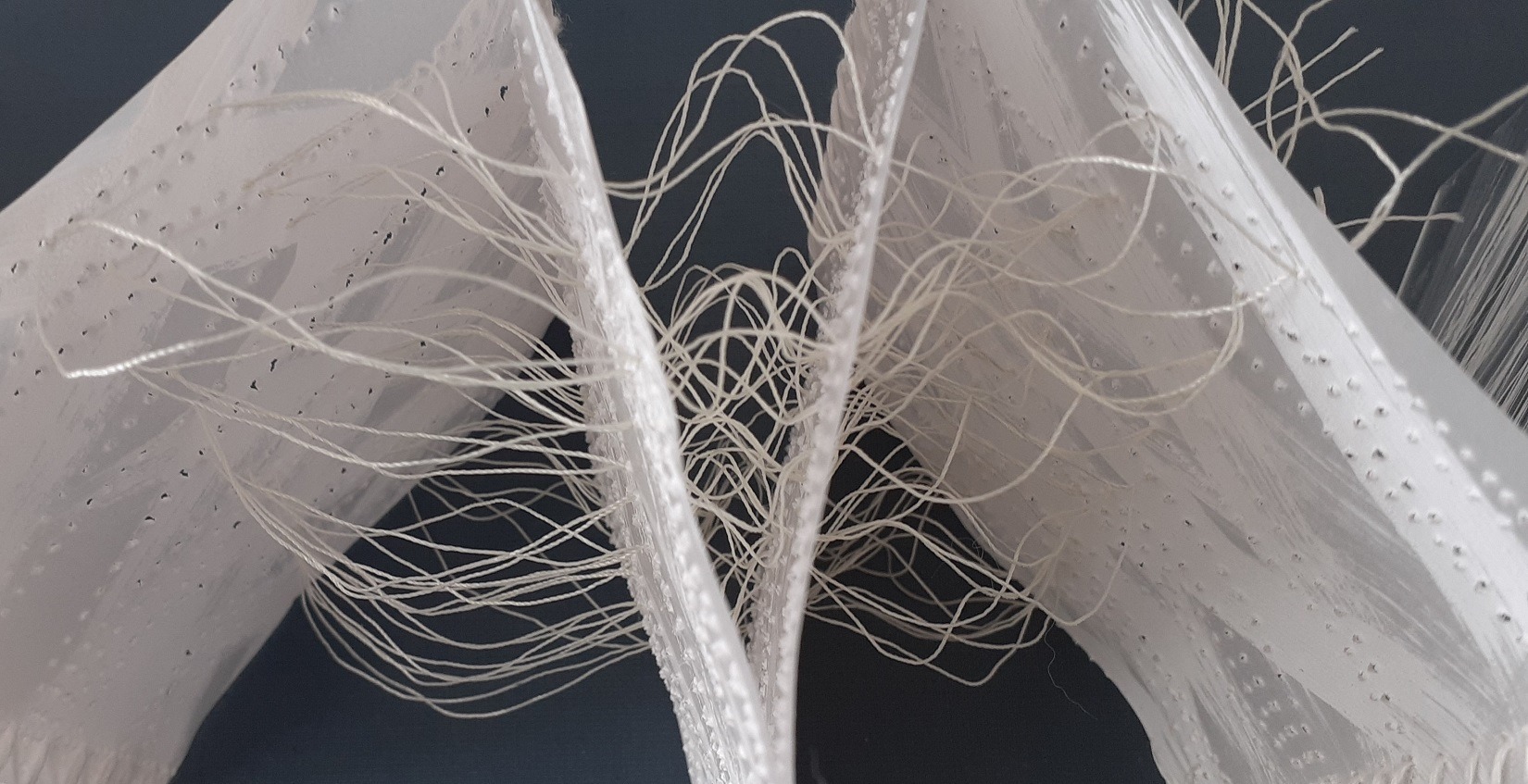
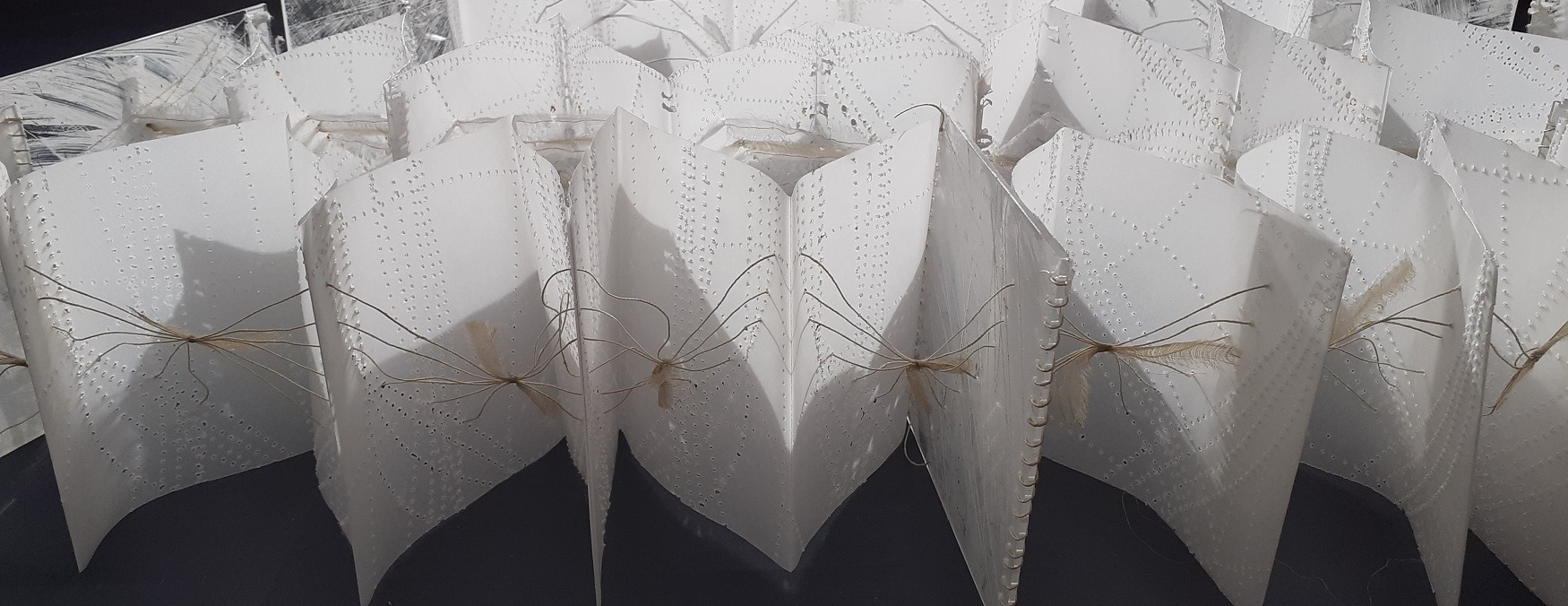
Rhythms of nature
Foldable translucent vellum and sheets of acrylic both allow the light through. These materials reference the ethereal atmosphere of the marshes.
The repeating concertina shape describes this watery and atmospheric environment, echoing the rows of reeds on the boundaries between the areas of water and the paths.
Each of the four rows of vellum concertinas ends with an acrylic sheet, for extra support.
A sewing machine using ‘threadless stitching’ became the perfect solution to create multiple lines of perforations through the vellum concertinas. Narrow strips of ripped chiffon and organzas are threaded through some of these holes, linking each of the folds in relaxed, flowing lines.
Fine lines of threads repeat, some with knotted chiffon to emphasise the textural qualities of the reeds and express atmospheric changes. And the rhythmical lines of threads and fabric strips are duplicated as painted marks on the acrylic end pieces, linking the vellum and acrylic together visually.
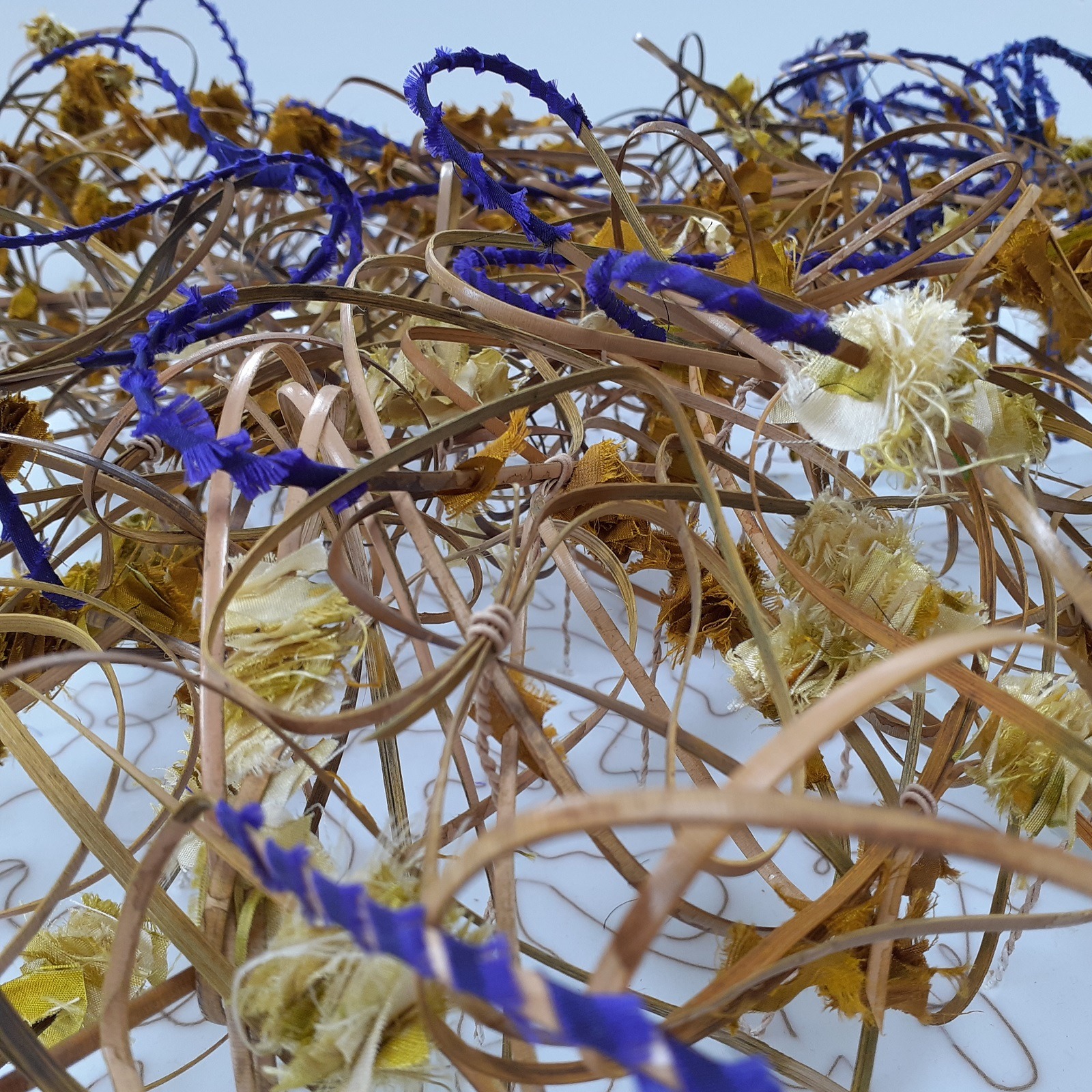
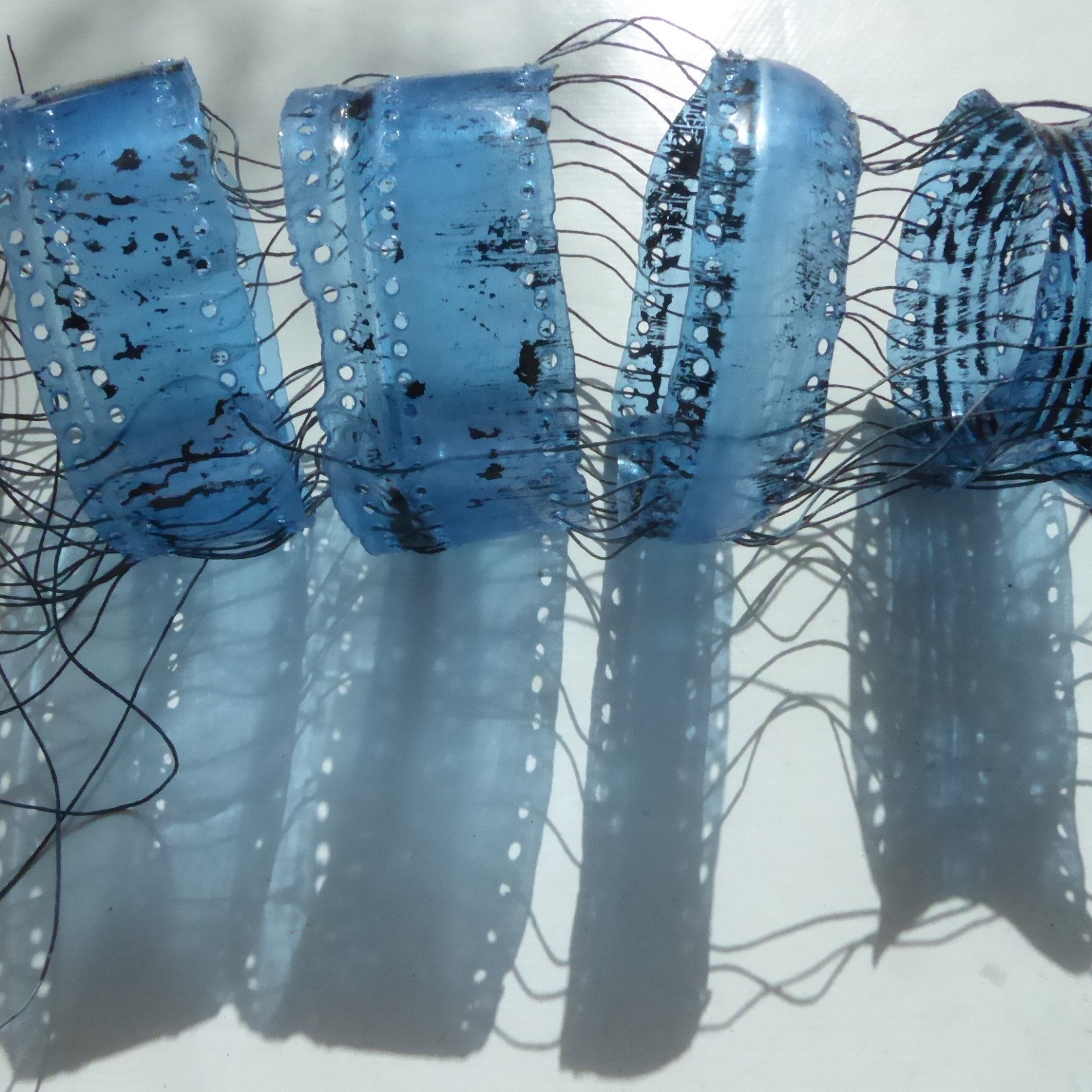
Willow and discarded debris
Siân deliberately takes a mixed media approach; she often chooses to include non-textile materials such as locally-sourced willow and collected objects in her artworks. And she likes to make use of discarded items found in her local landscapes. This mixed media approach, along with a deep personal connection with the environment, allows Siân to hone in on the rhythms of nature found in her native surroundings.
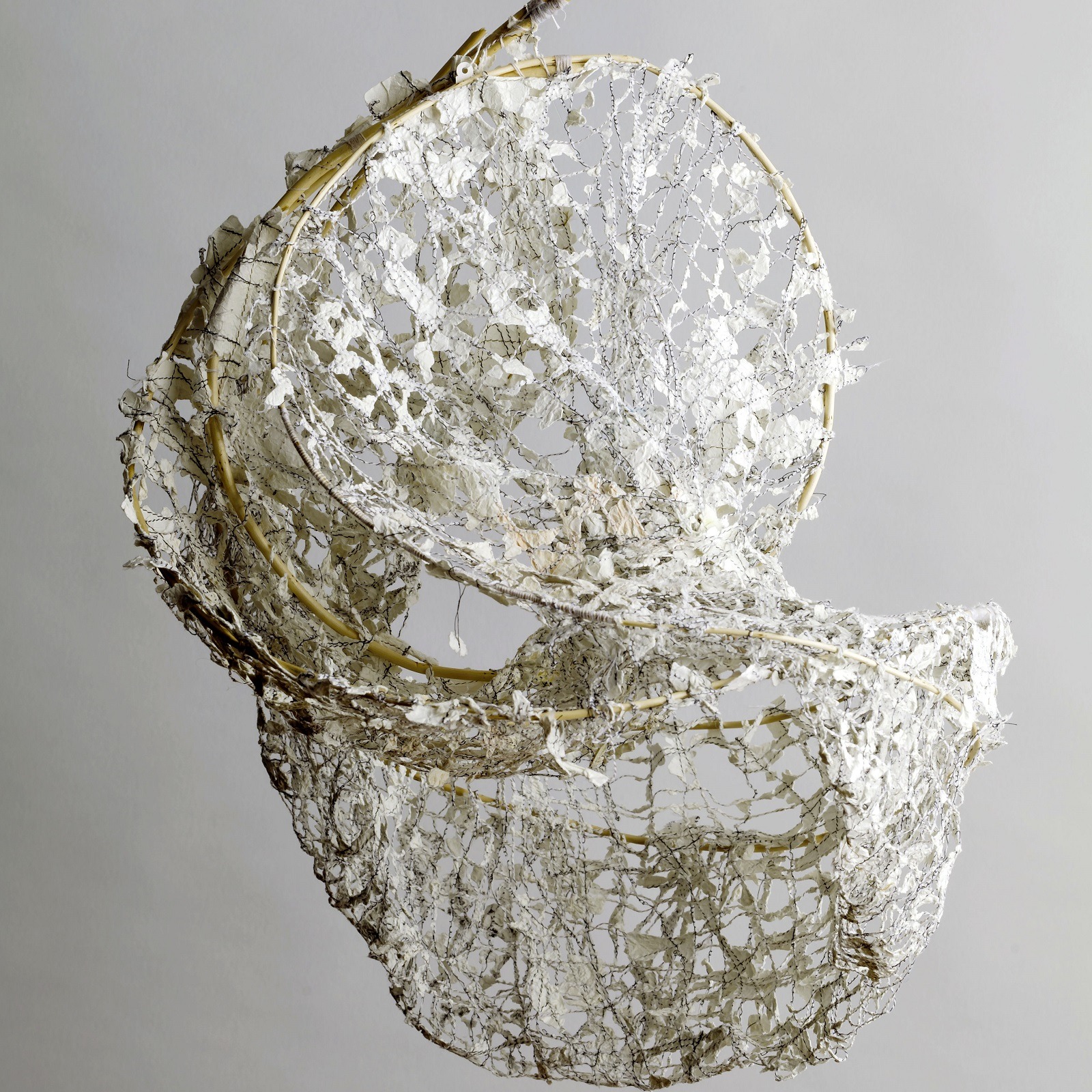
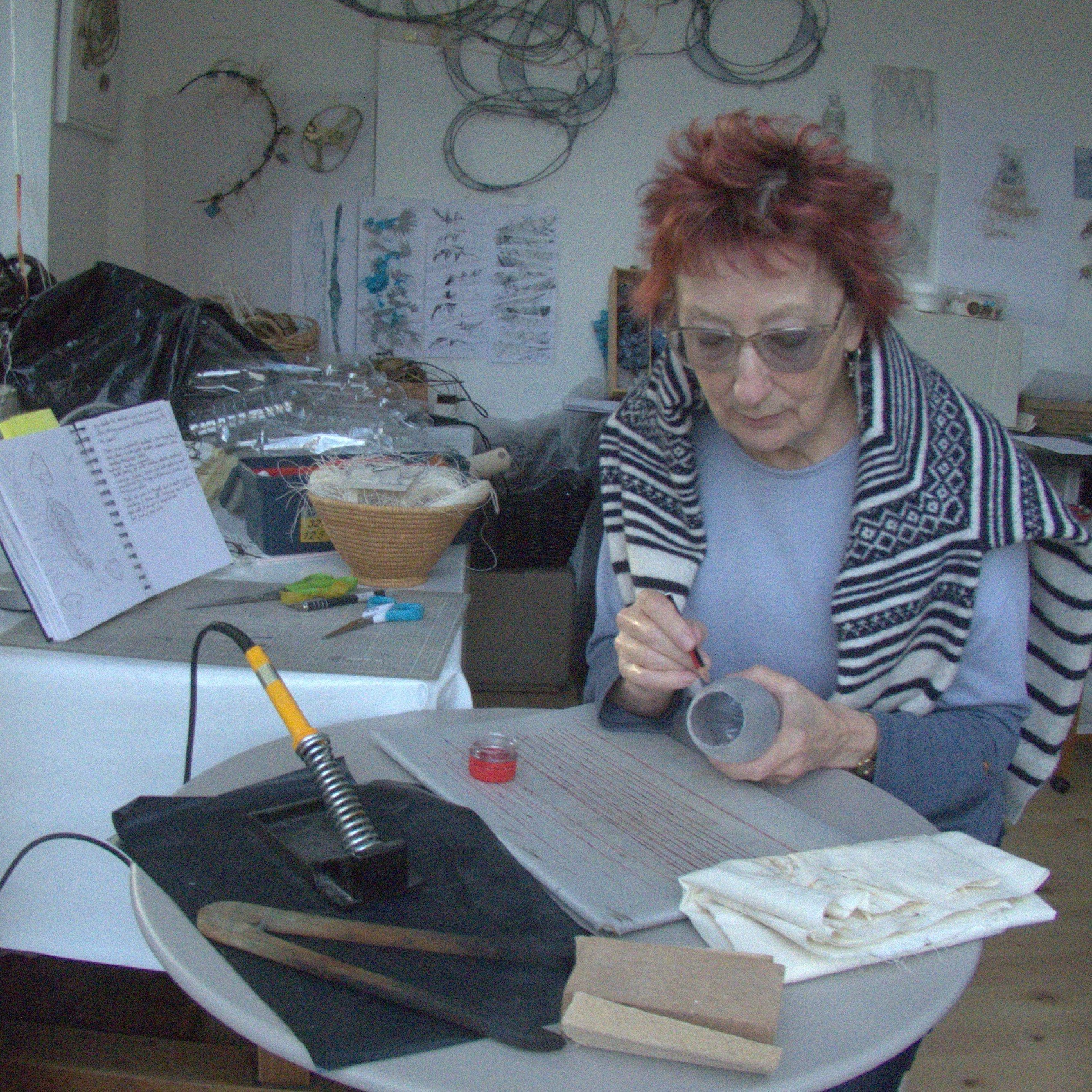
Textile artist Siân Martin is a member of the 62 Group of Textile Artists and the Textile Study Group, exhibiting widely in the UK, Australia, Sweden, Paris and Tokyo. She also exhibits in a group Artwork Together, with two fellow Somerset artists. Siân continues to inspire students through her teaching. Her work has featured in publications including the recent books Insights and Dis/rupt, by the Textile Study Group, and Ctrl/Shift – New directions in Textile Art, by the 62 Group.
Website: www.sianmartinartist.com
Blog: www.stitchloop.blogspot.co.uk
Facebook: facebook/SianMartin2012
Instagram: @sianmartin1335
June Lee
June Lee’s delightful and explosive mini-figures clearly convey the invisible social and psychological ‘weights’ of our modern existence, the balance of relationships and social responsibilities collected and maintained during a person’s life.
‘While people’s lives have become more convenient in this fast-paced society, the psychological burden and stress has also increased. My work expresses the large weight of life we carry in contemporary society, through figures entangled with miniature renderings of everyday objects, tools, and other items symbolising status and rank,’ June says.
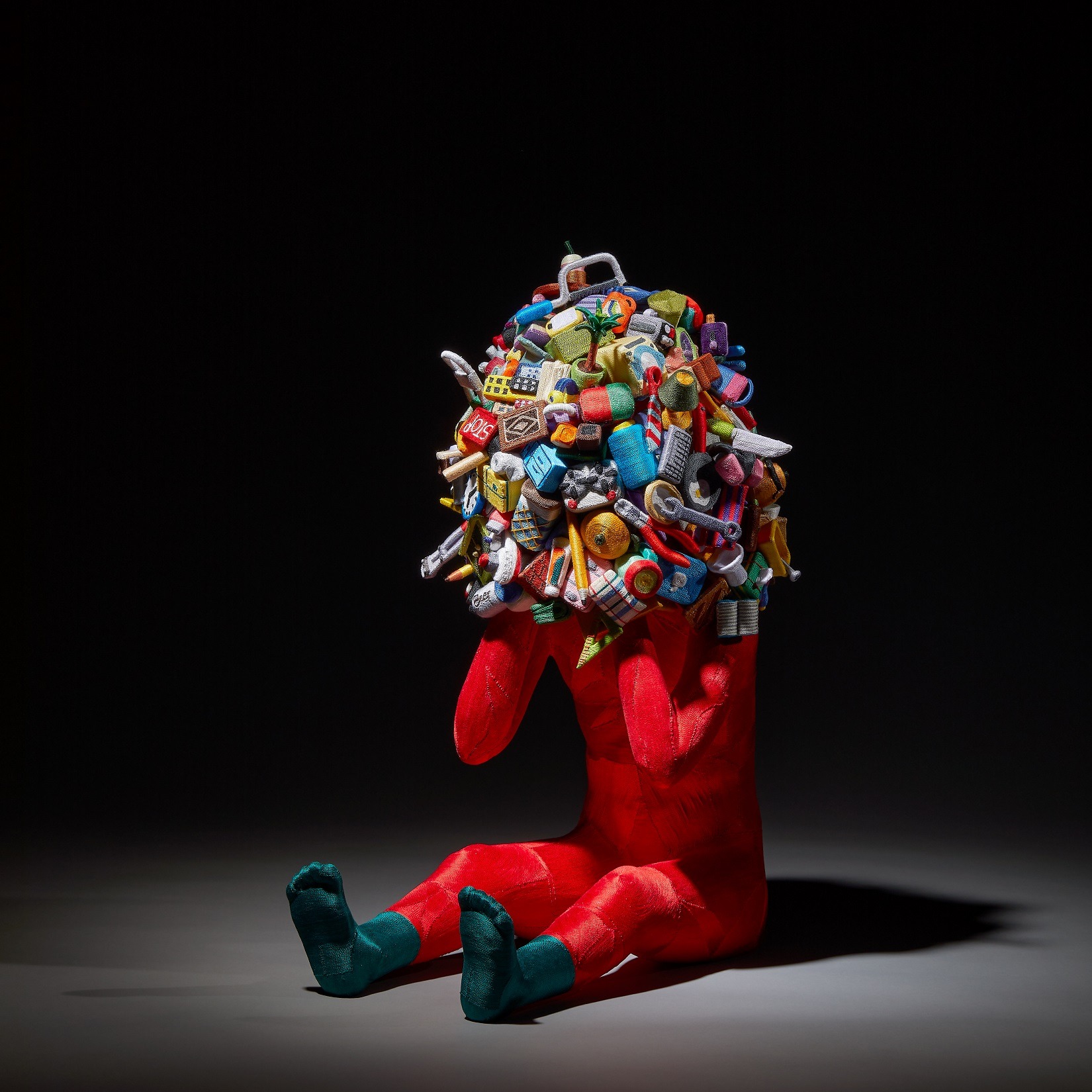
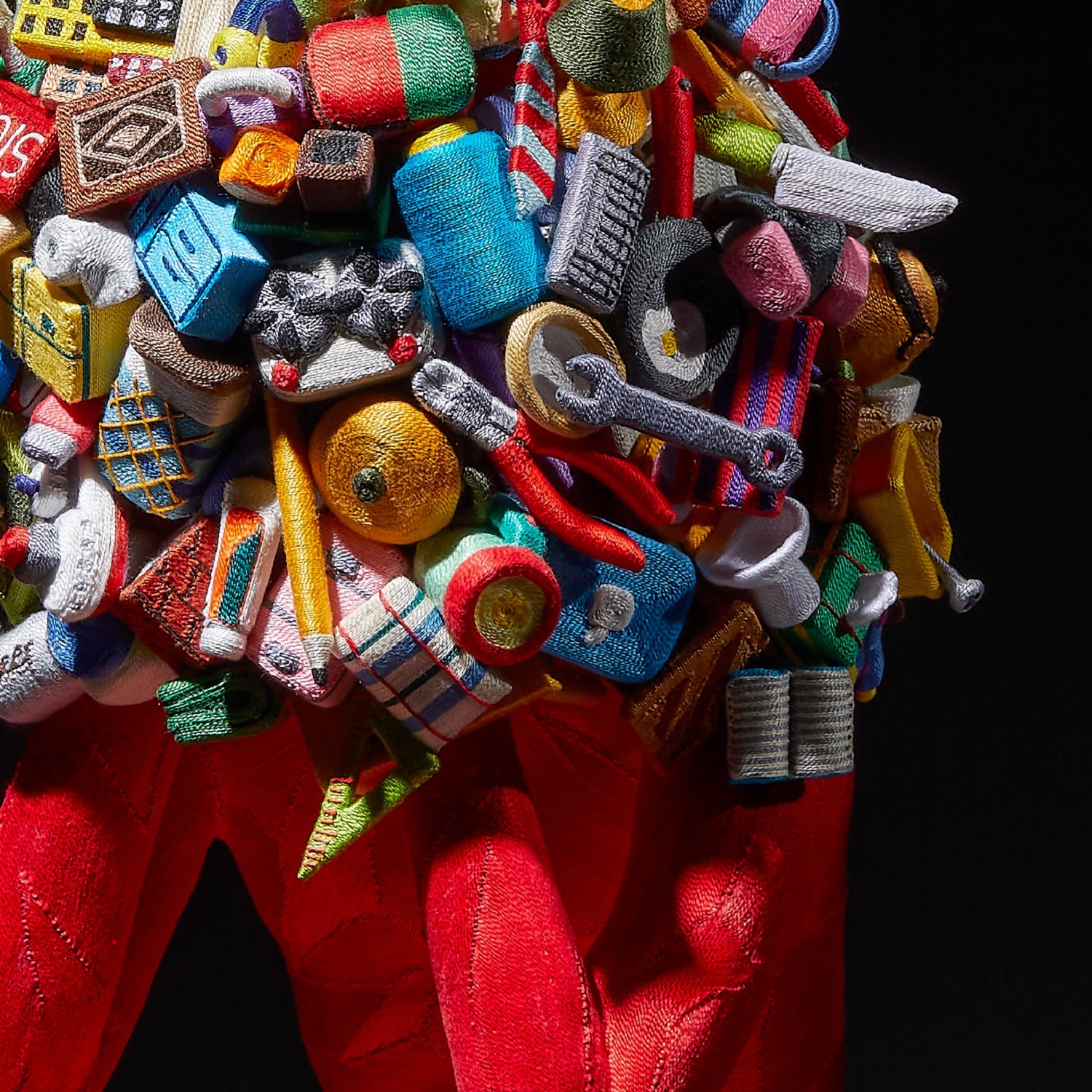
Clear communications
‘I mostly explore issues of humanity and society. Mixed media is the best way of communicating my thoughts. I prefer it because it is not abstract and is easy for the viewer to read.’
As an undergraduate, June studied painting and drawing but became afraid of the blank canvas or paper. This fear developed into a psychological barrier. ‘I didn’t know what to draw or paint. It was really hard for me to express my ideas, thoughts or messages through the 2D flat surface,’ she says.
Searching for an alternative medium, June started to colour thick yarns with acrylic paints and patch them onto canvas. And she began wrapping threads around collected objects, clay shapes, or figures cast with resin. The fear and pressure quickly disappeared.
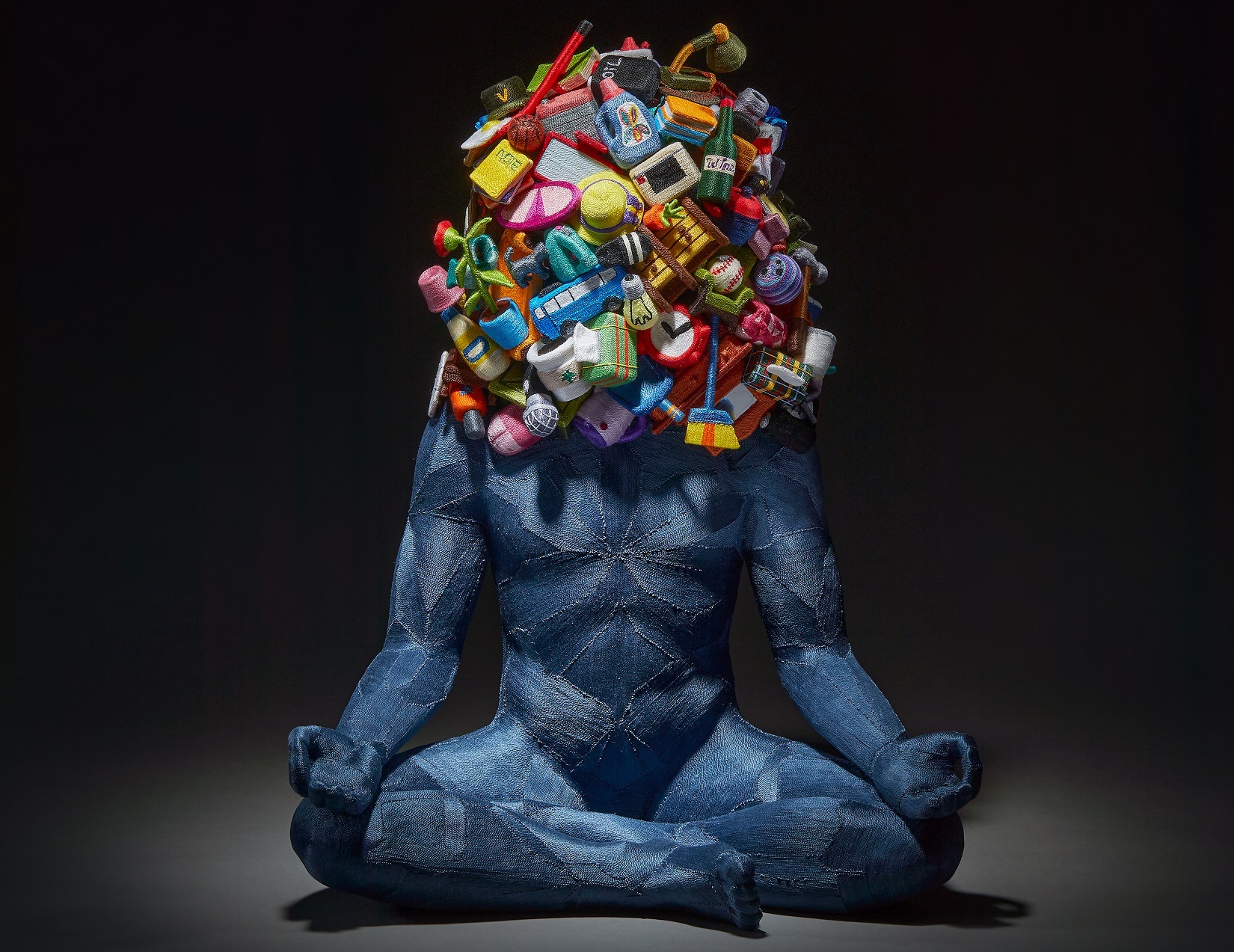
In her Weight of Human series, June’s resin cast figures are first wrapped with threads.
She loads up these figures with an intriguing collection of miniature plastic toys, as well as symbolic items that are made with Sculpey polymer clay and baked. All of these shapes are wrapped with threads, too, adding to the tactile nature of these works.
June’s choice of media, with the textured surface detail of the thread work and the colourful mass of familiar objects, helps to exuberantly express the complexities of modern life.
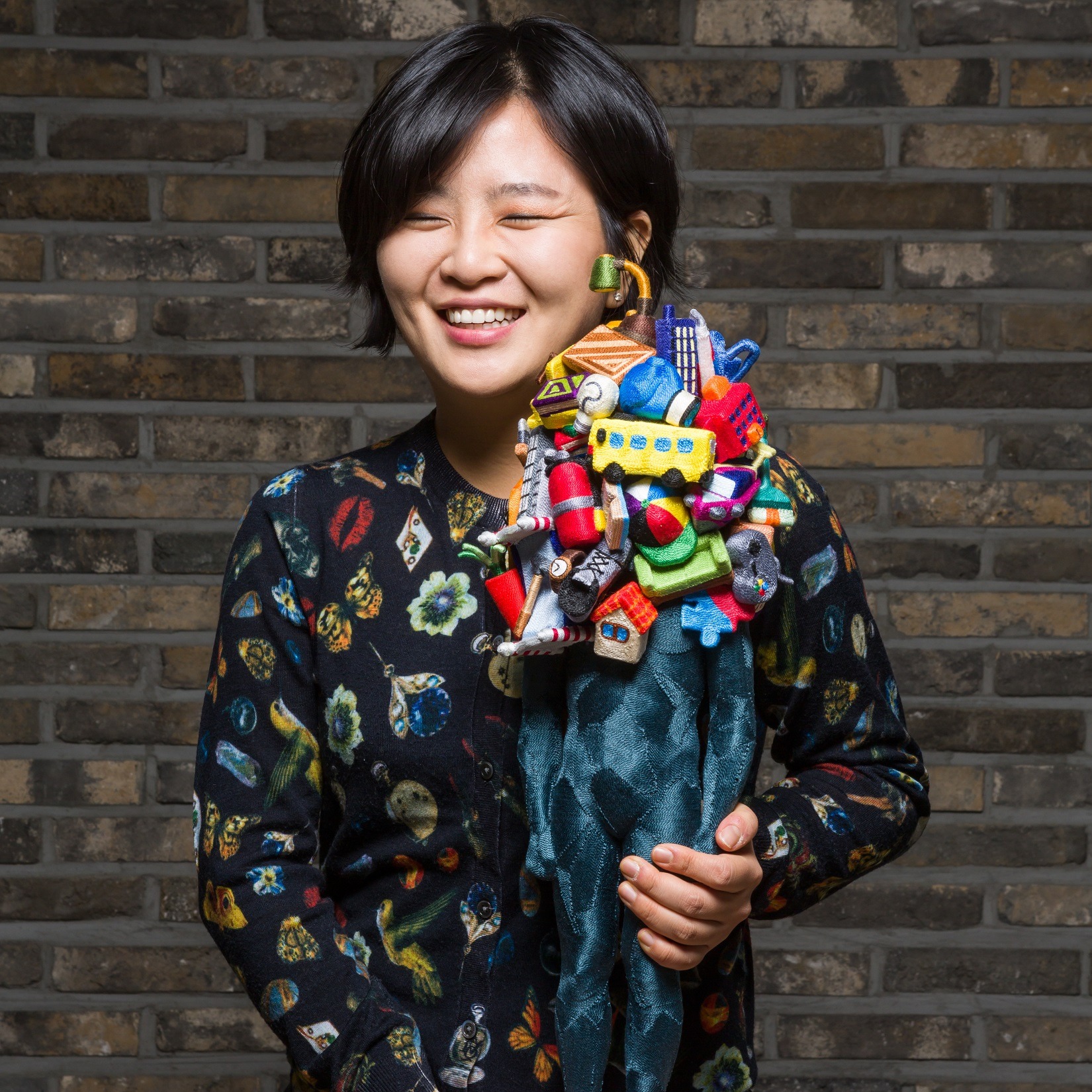
June Lee is from Seoul, South Korea. She studied in the US before returning to live in South Korea. She has participated in artist-in-residence programmes in the US and worldwide, and has exhibited in numerous exhibitions. In 2021 June was awarded Best in Show at the Interpretations 2021 competition, Vision Art Museum Biennial, US.
Website: www.junelee.kr
Instagram: @artist_junelee
Nerissa Cargill Thompson
Blending together textiles and concrete is an unusual approach. But this is how Nerissa Cargill Thompson addresses environmental issues through her work. By using recycled materials she can work sustainably, while referencing the ever-growing mountains of plastic pollution.
In No Man is an Island: Mapping the Issue embellished textiles are conjoined with concrete shapes cast using discarded plastic packaging. The result is a texture reminiscent of coastal cliff ecosystems, with pockets of flora existing in rock crevices. This work demonstrates how our waste materials are subsumed into the natural world.
Nerissa combines a variety of recycled fabrics using an embellisher machine. This produces subtle and naturalistic variations in tone.
‘My work investigates change over time, not just erosion or decay but new layers of growth, giving juxtapositions of structure and colour.’
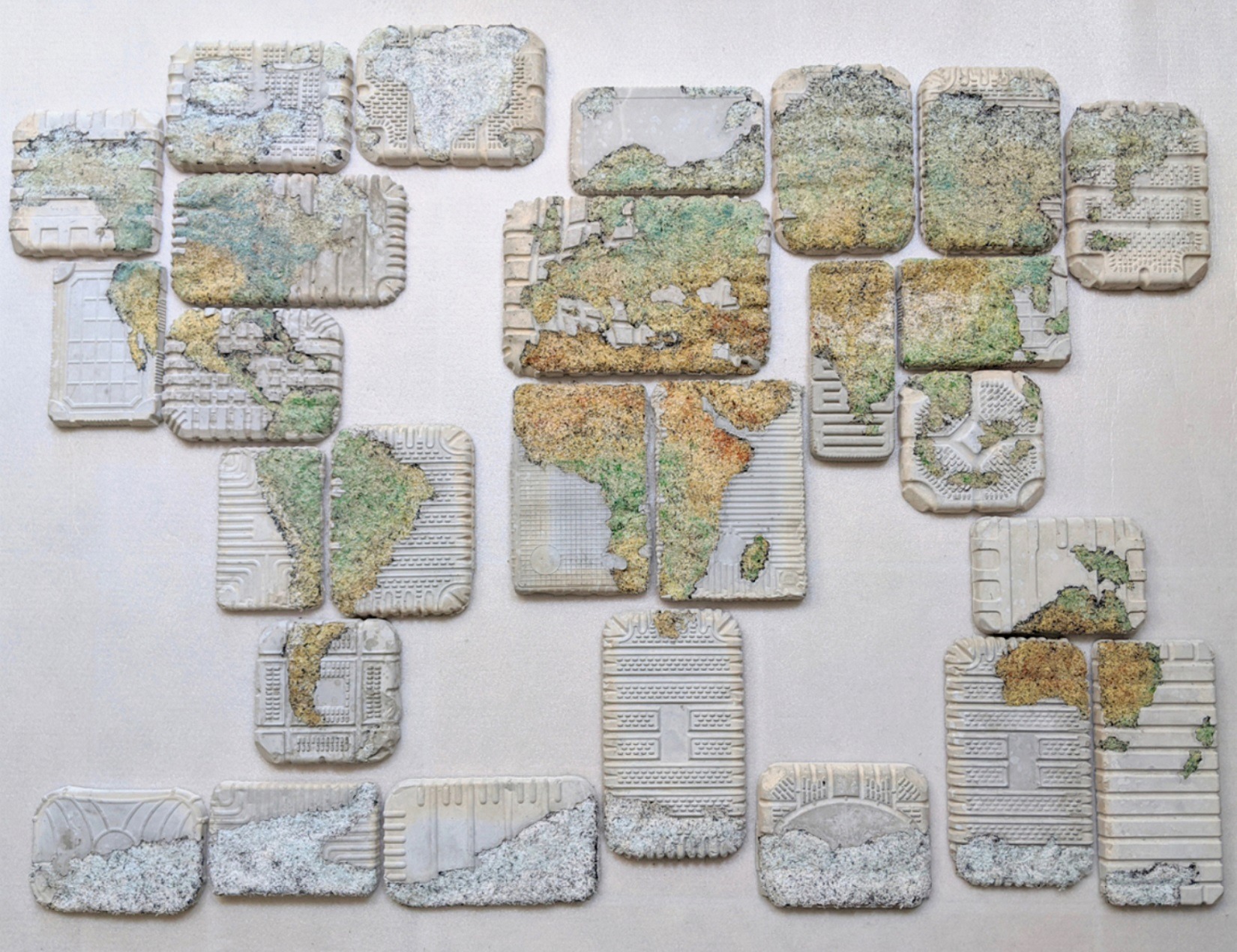
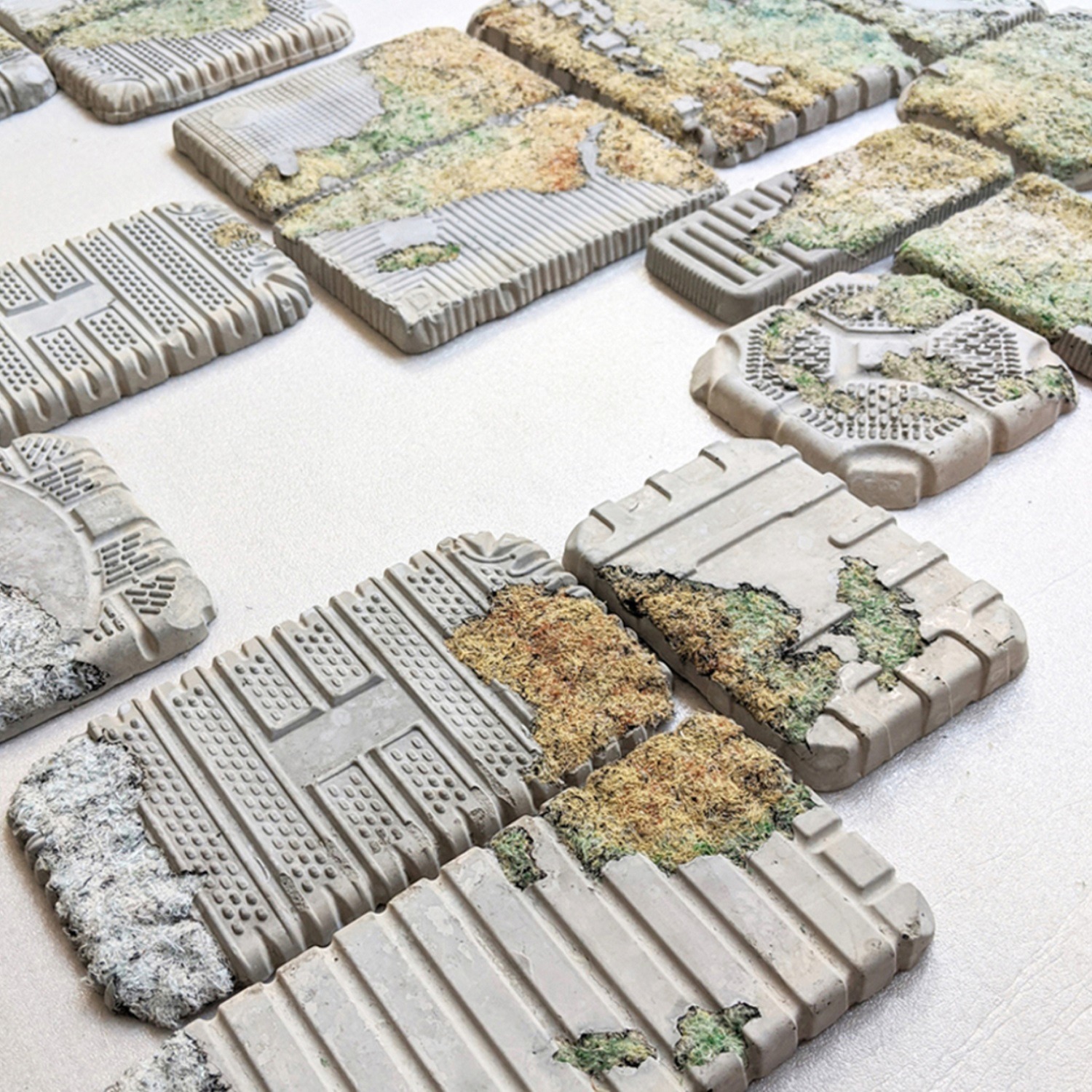
A world plagued with litter
‘Inspired by media coverage of the Great Pacific garbage patch and the uninhabited islands plagued by our plastic waste, I wanted to create a piece examining how our waste has invaded every part of the planet.’
However, using household waste restricts the size of each element of her artworks. To work on a larger scale, Nerissa uses multiples. But each piece is unique, with the textiles carefully stitched into the plastic to control their position.
Embellished old clothes and fabric scraps are split across a collection of domestic food trays. It’s a reminder that change starts in the home, on a small scale, and that each of us is responsible for change.
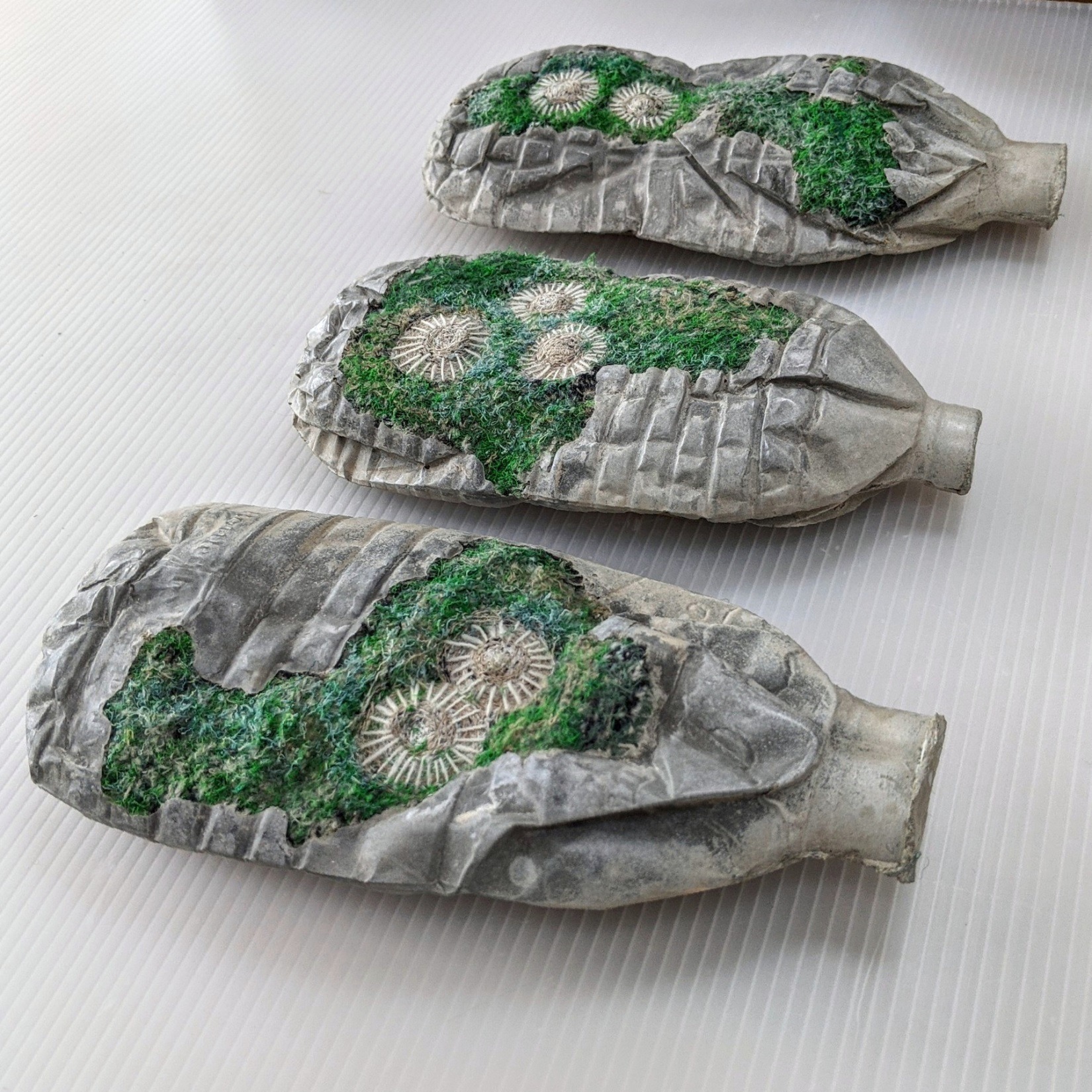
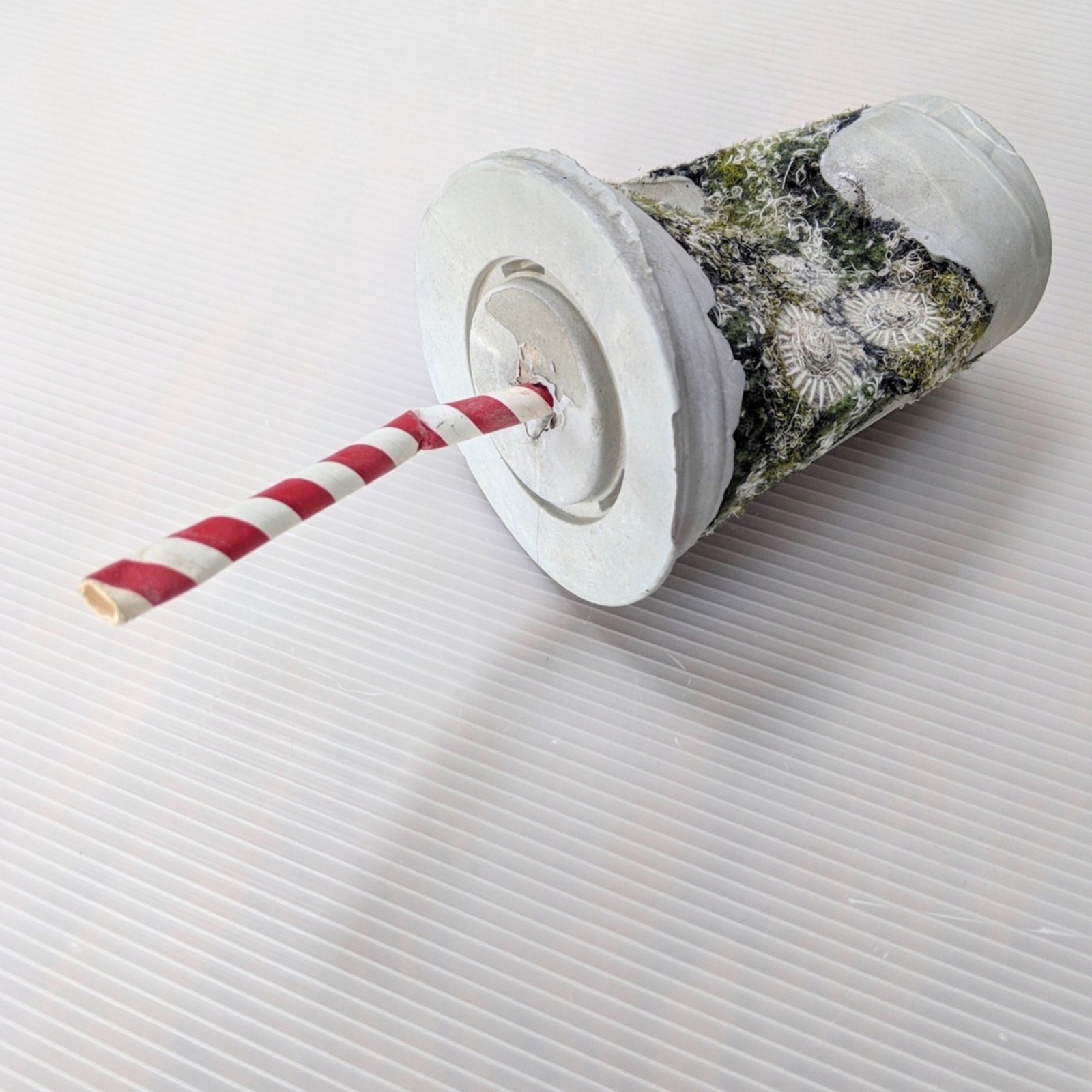
Nature fights back
Mixed media and working in three dimensions came naturally to Nerissa, as her background is in theatre prop-making.
First, she experimented with different ways to use recycled textiles and plastic waste, such as covering casts of plastic trays and milk bottles with textiles. But eventually she developed a process where she stitches the textiles into the plastic trays and then casts them in concrete, which connects the textiles and concrete together. She enjoys the juxtaposition of these two intertwined components.
This is the battle between nature and the manmade. Waste becomes embedded in the environment, but nature fights back.
The plastic trays leave grid patterns in the concrete, reminiscent of map markings. And the collection of cast elements group together into a map of the world.
‘The concrete is key in supporting the concepts of my work. Single use plastics are lightweight and transparent or translucent. They are easy to overlook and disregard. The concrete gives the waste a weight and substance in line with its longevity.’
Concrete has an urban quality, capturing the embossed logos and geometric textures of the plastic waste. And it contrasts with the soft, nature-inspired textiles embedded within.
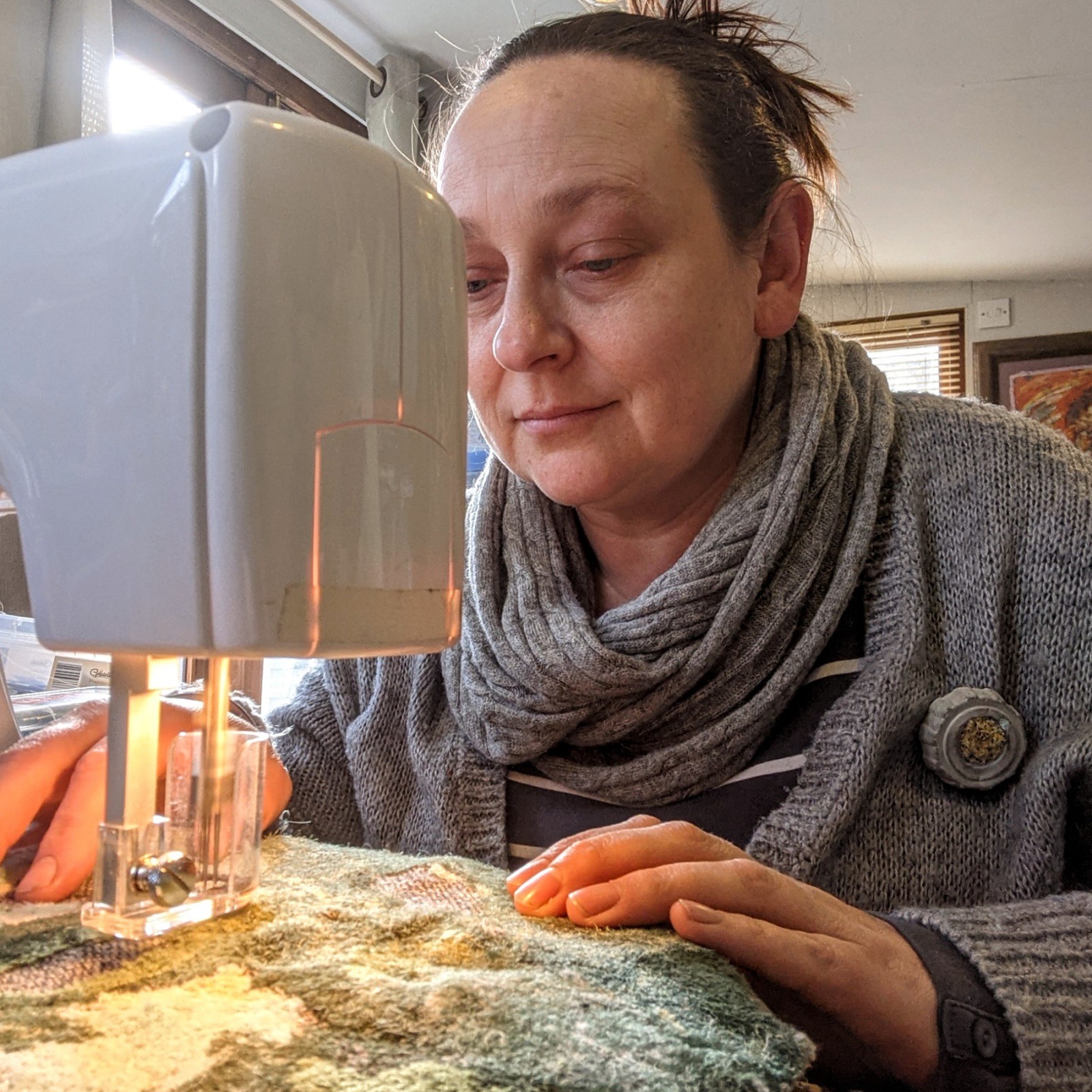
Nerissa Cargill Thompson is based in Manchester, UK. She originally trained in theatre design then developed an interest in fibre art through her community arts practice. She holds a MA in Textile Practice from Manchester School of Art (2018). No Man Is an Island: Mapping the Issue was shortlisted for the Fine Art Textiles Award in 2020 and won second prize in the Sustainability First Art Prize 2021. Nerissa is a member of Prism Contemporary Textiles Collective, the Society for Embroidered Work, ArtCan and Design Nation.
Website: www.nerissact.co.uk
Facebook: facebook.com/nerissact
Instagram: @nerissact
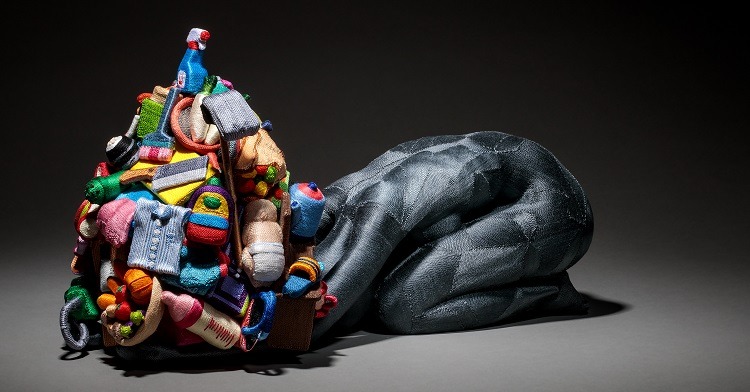
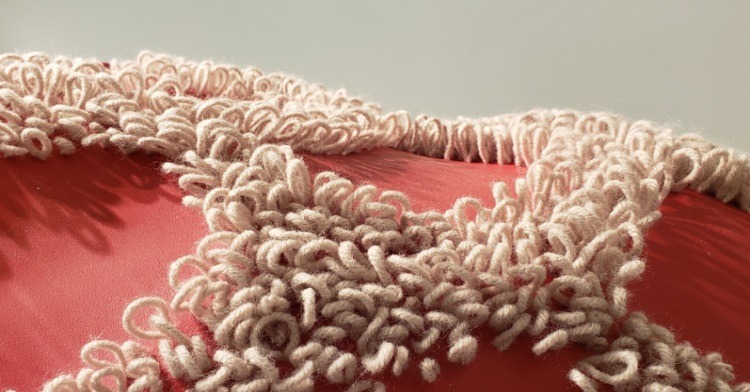
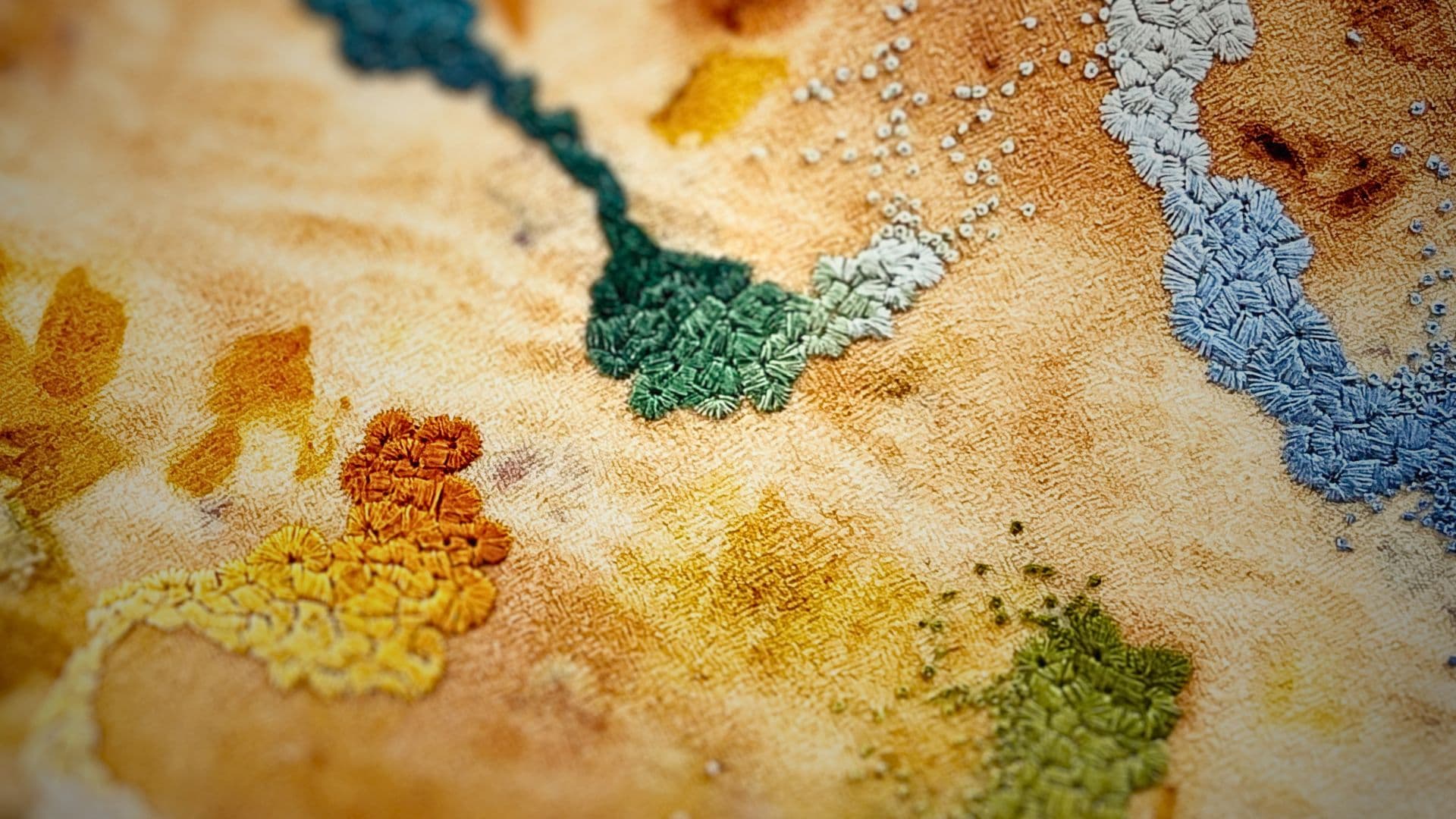
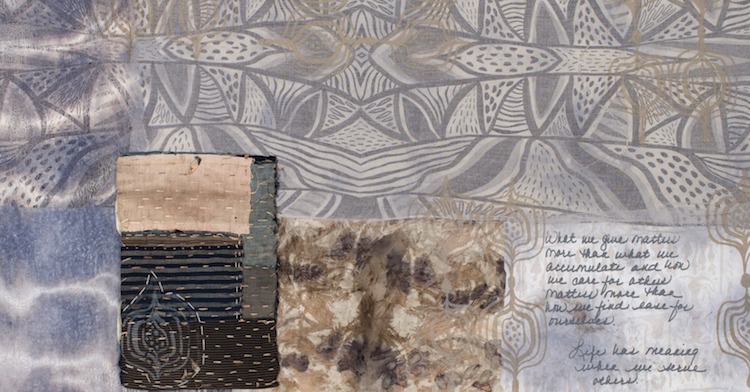
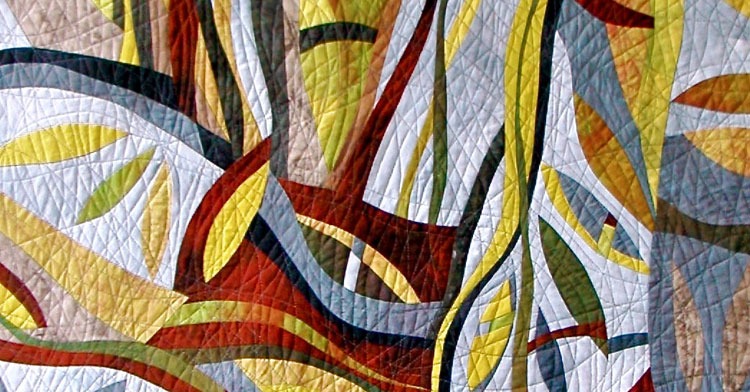
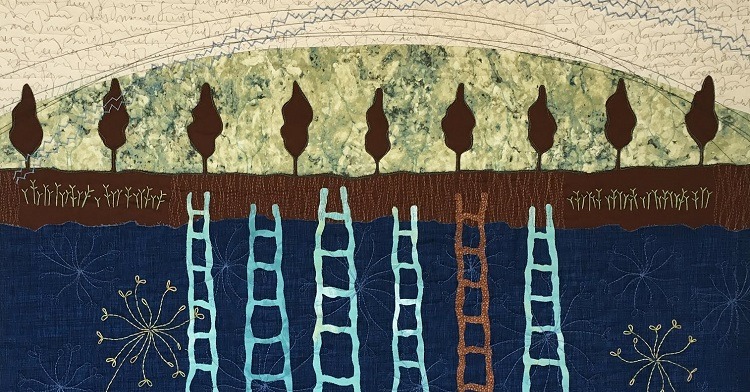
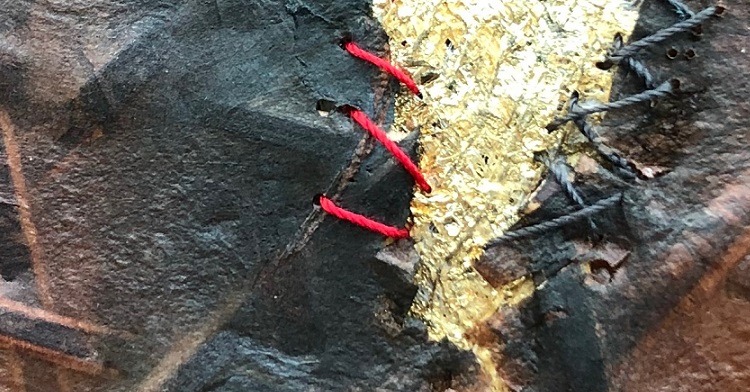
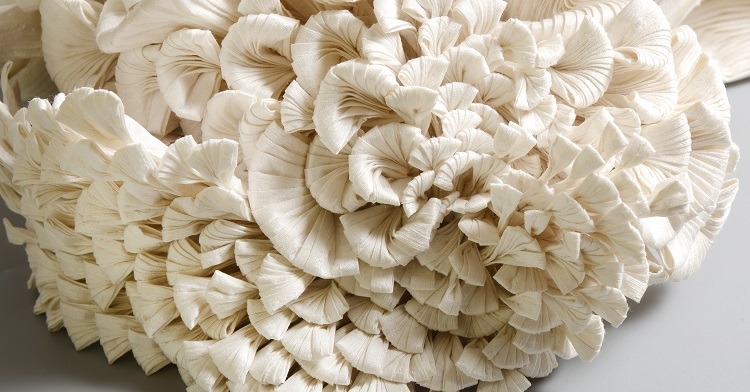

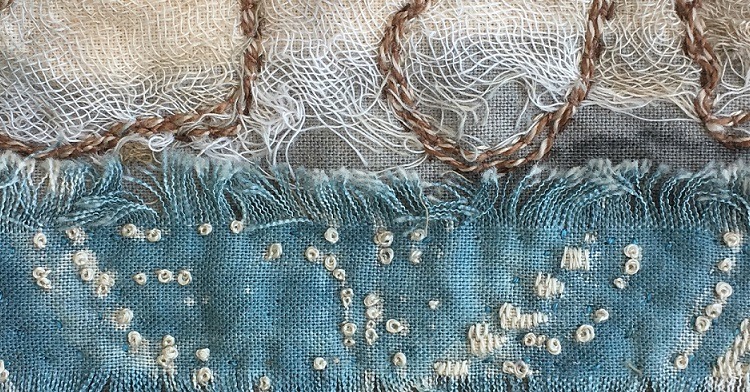
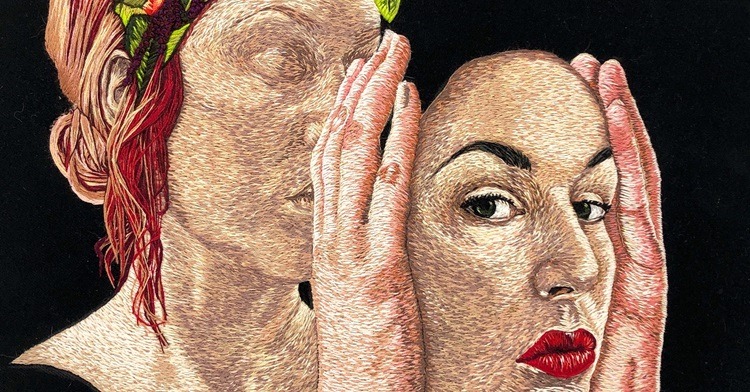
Comments